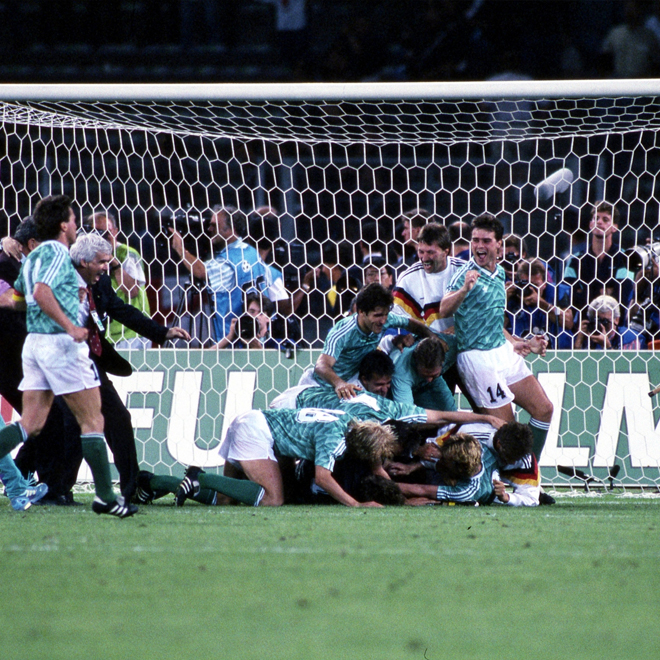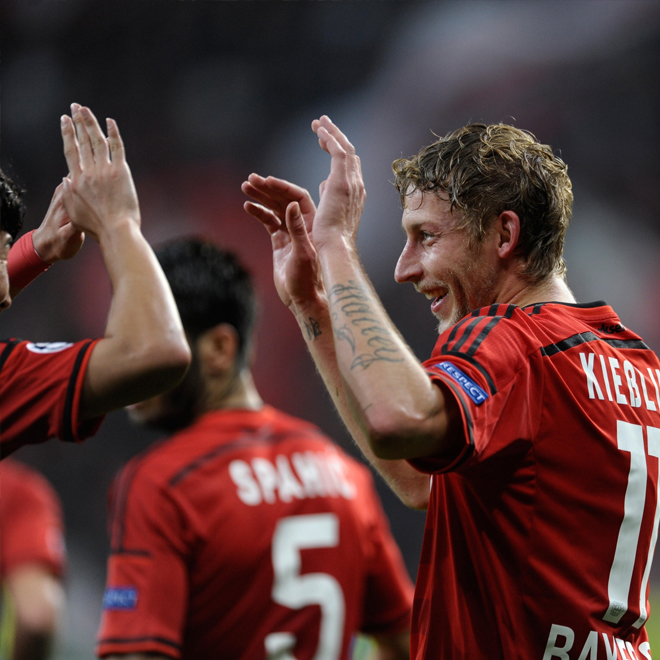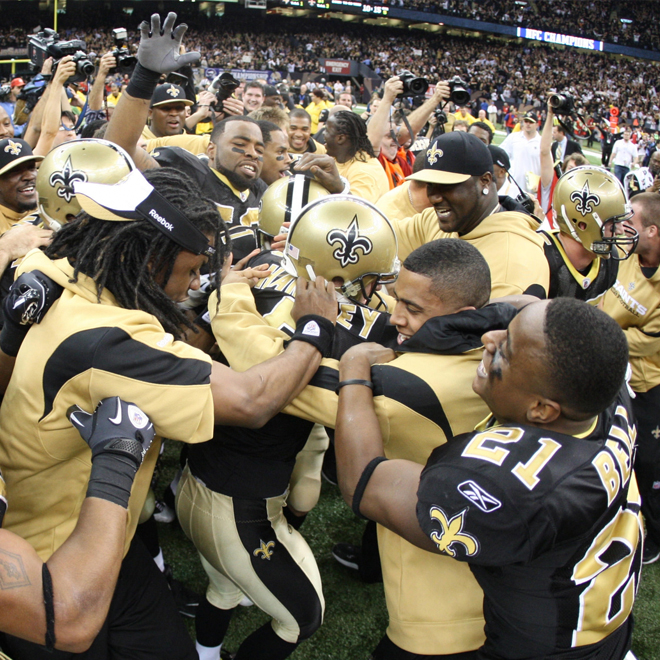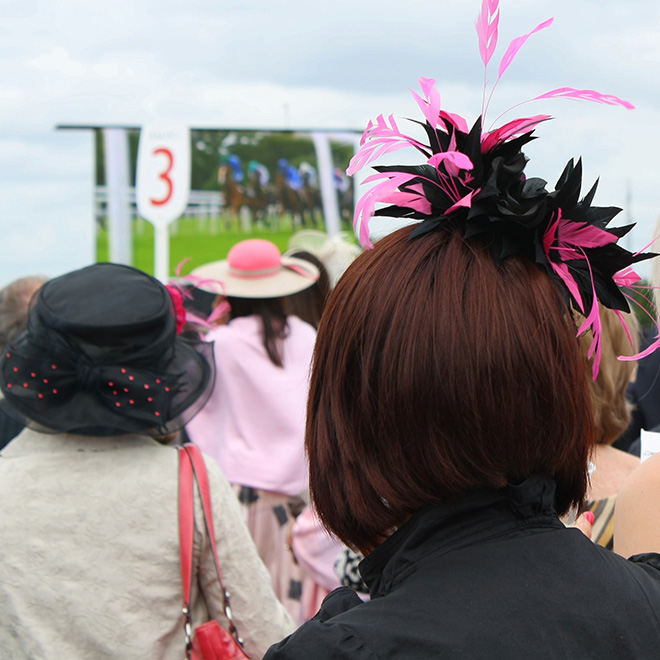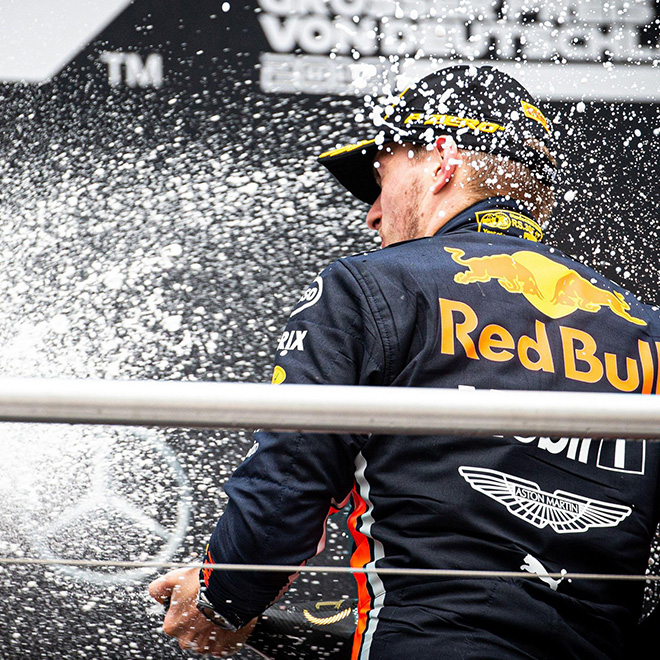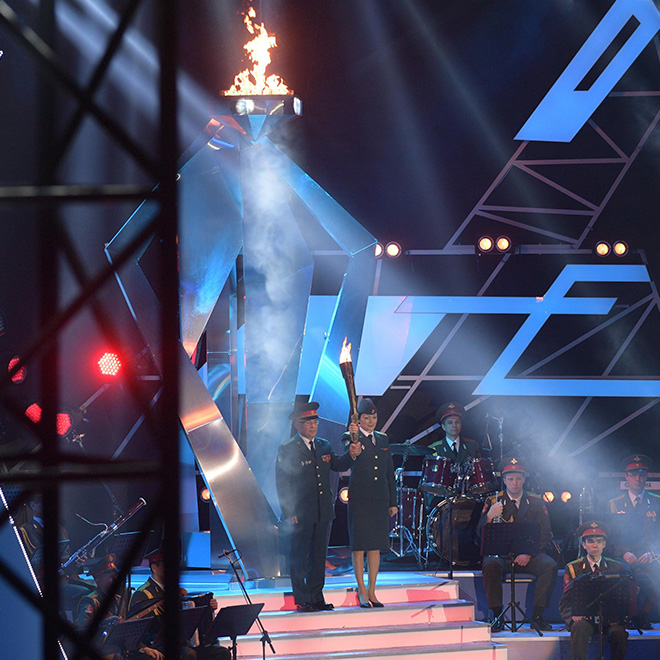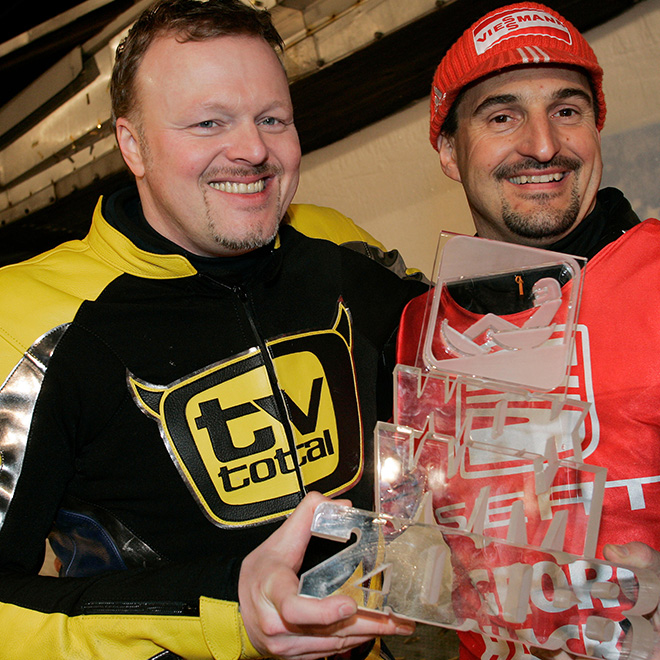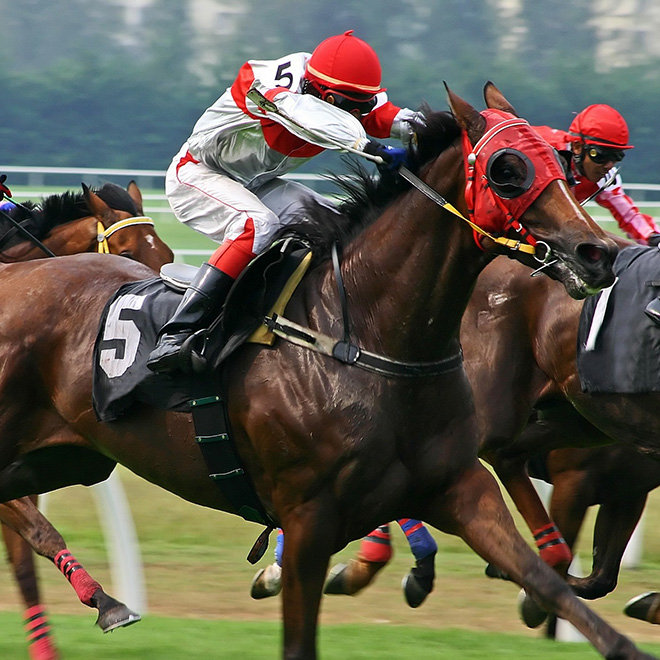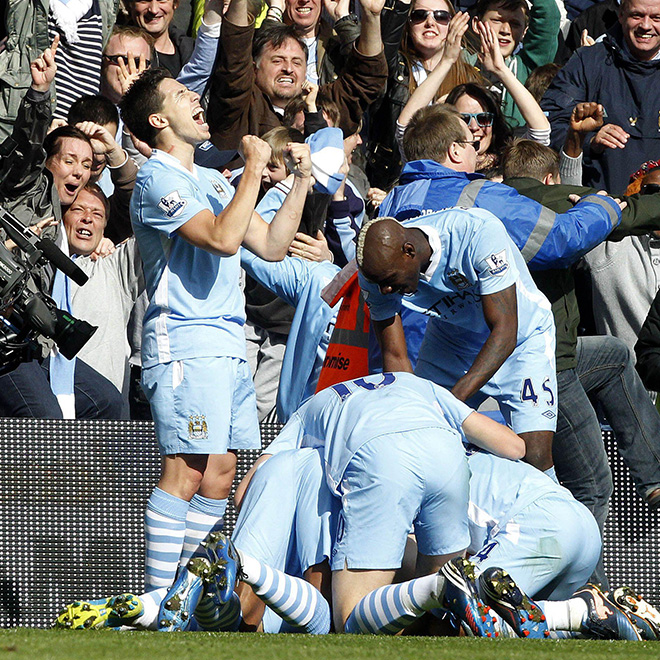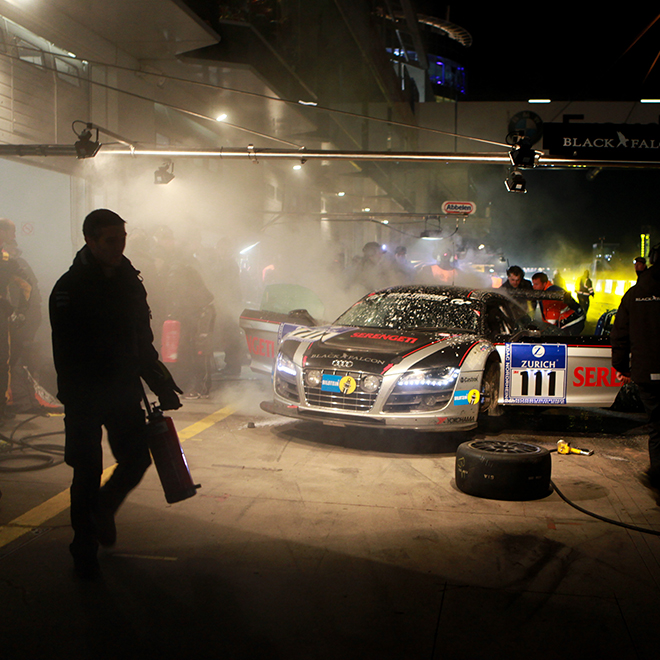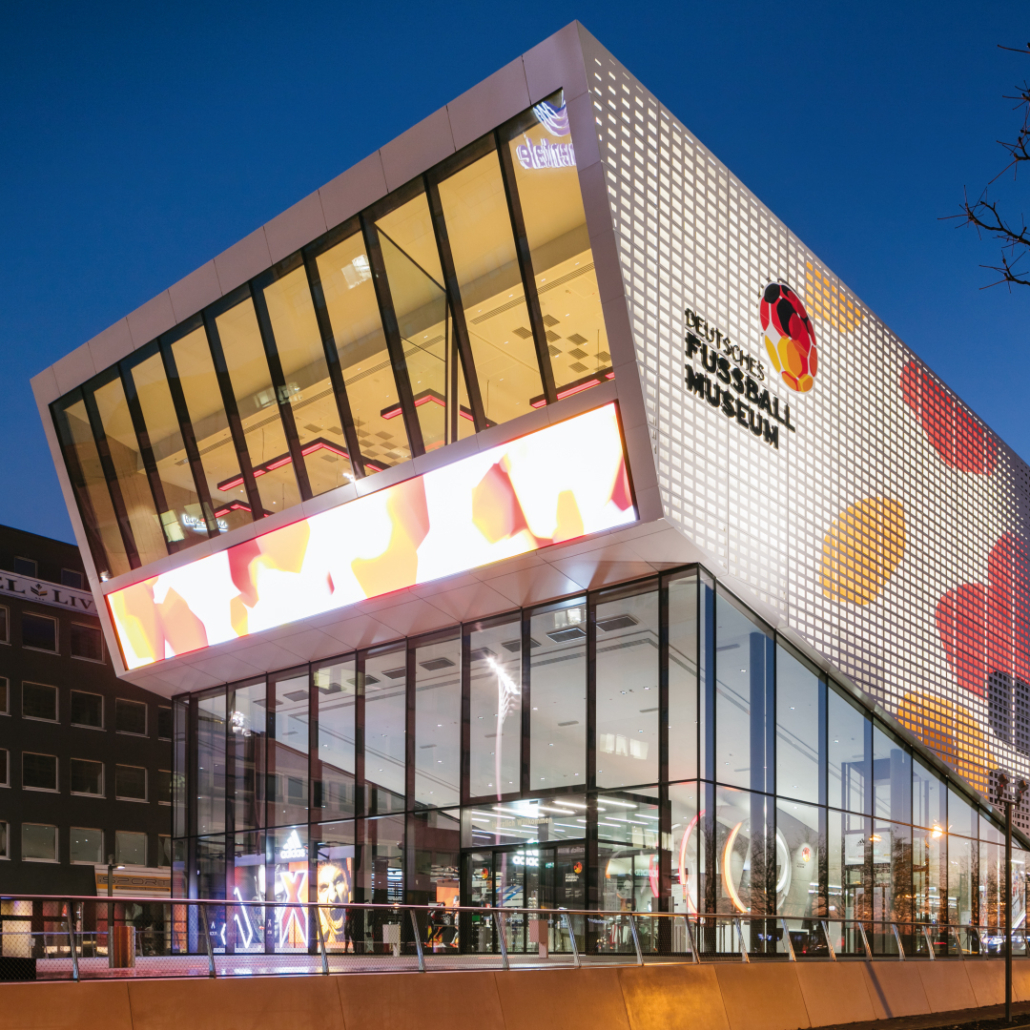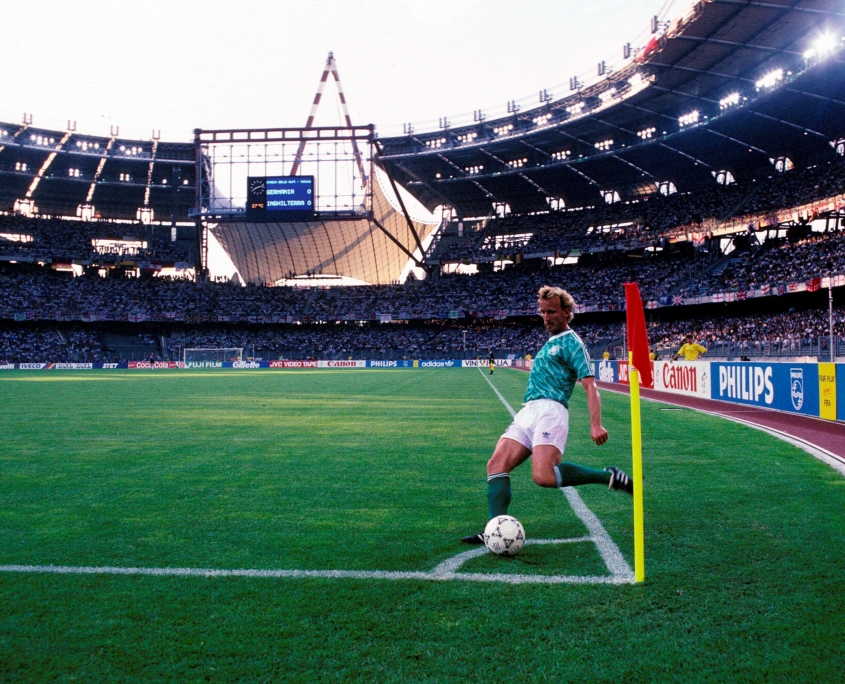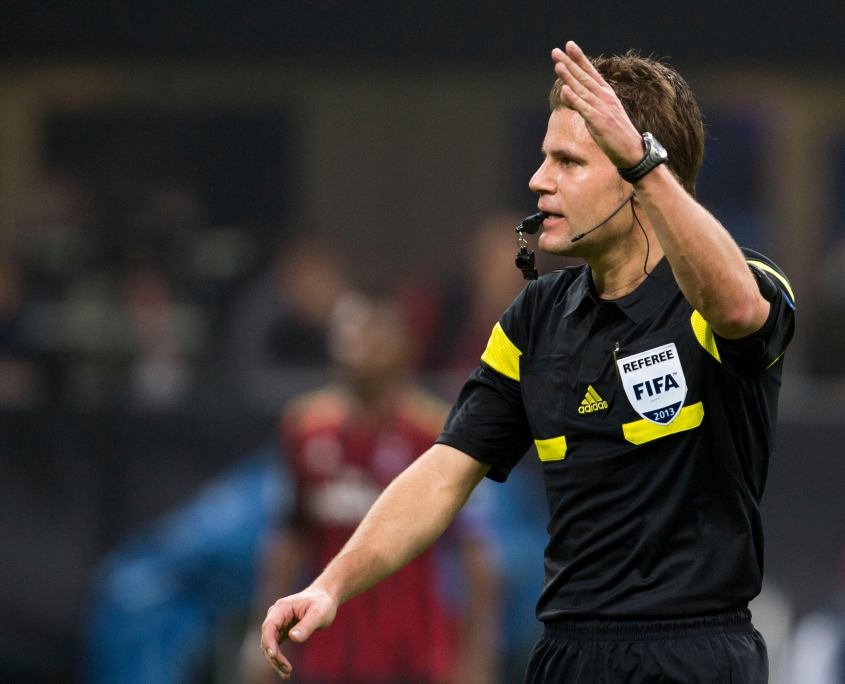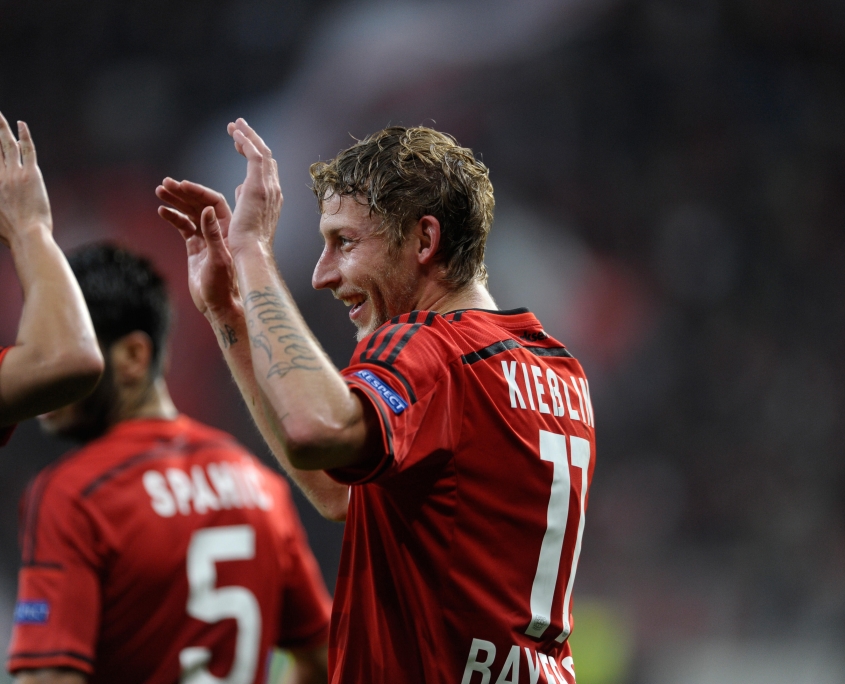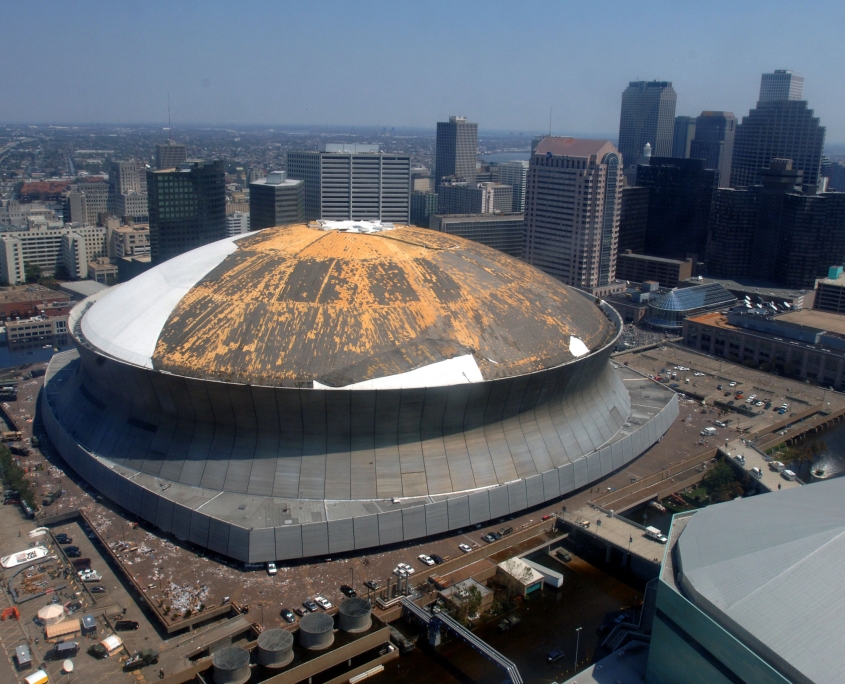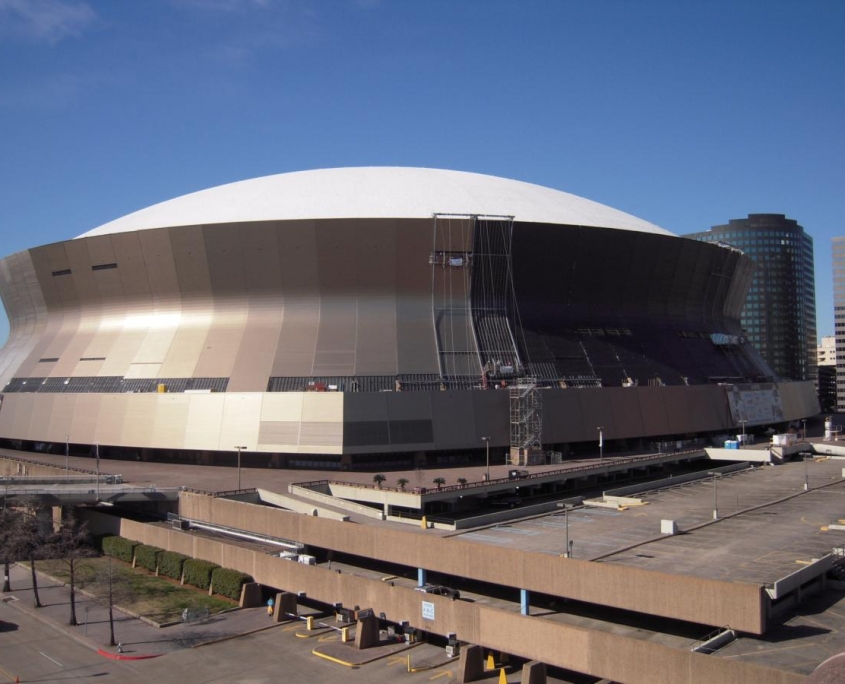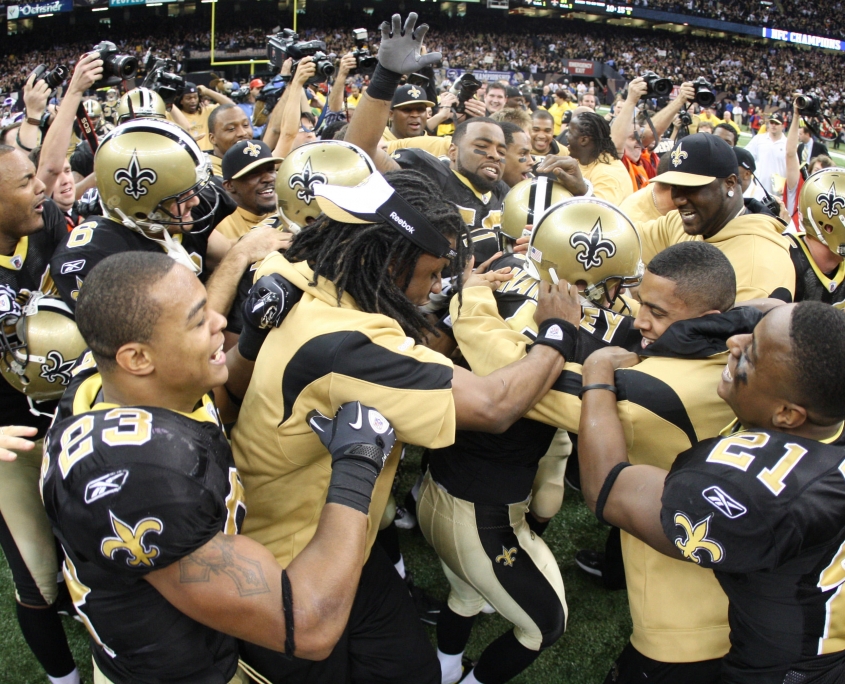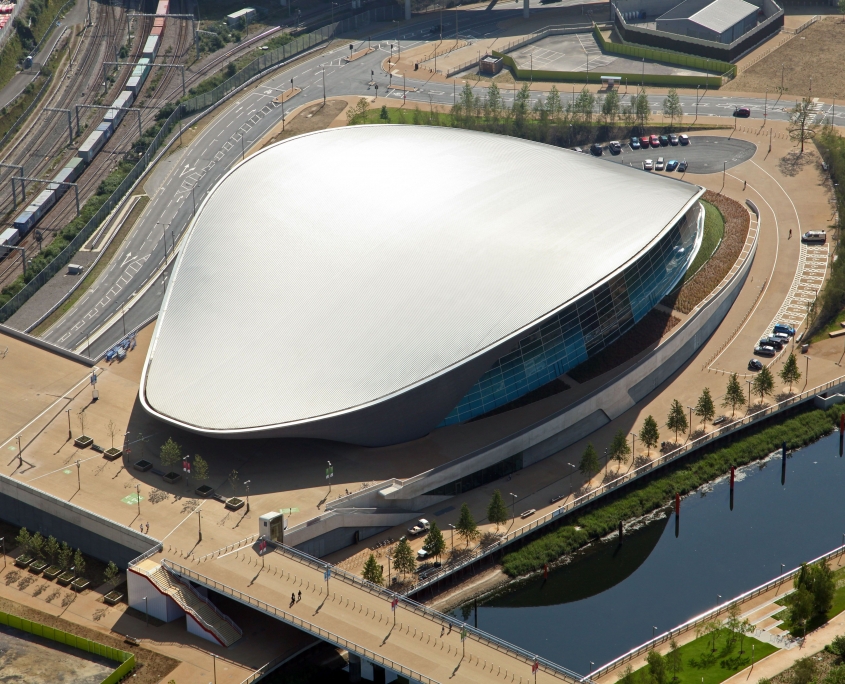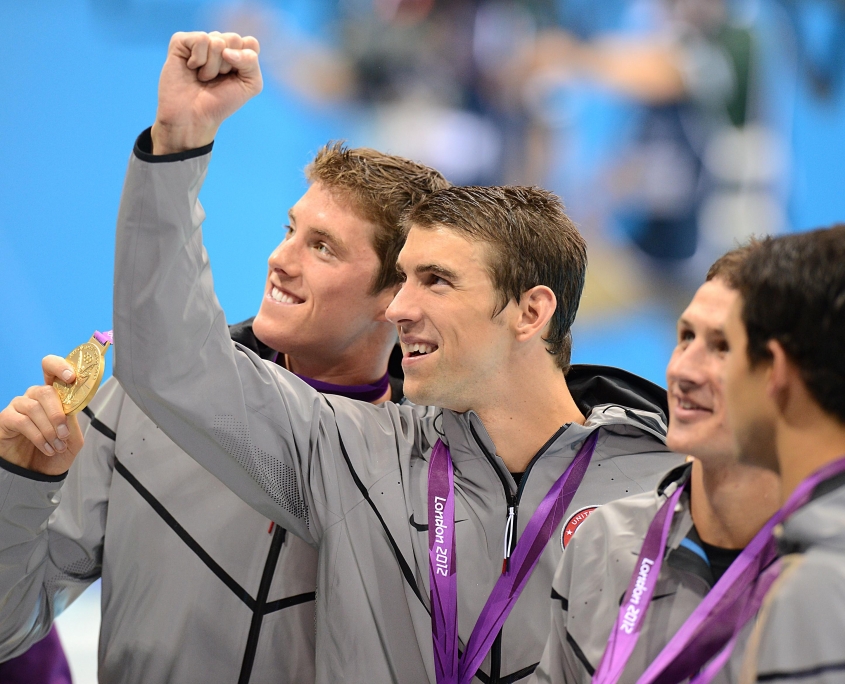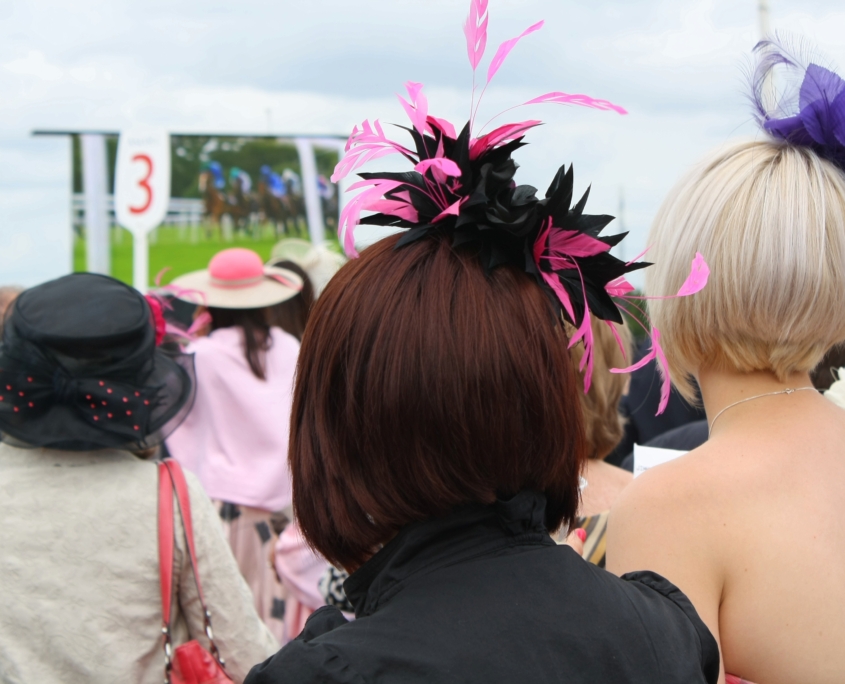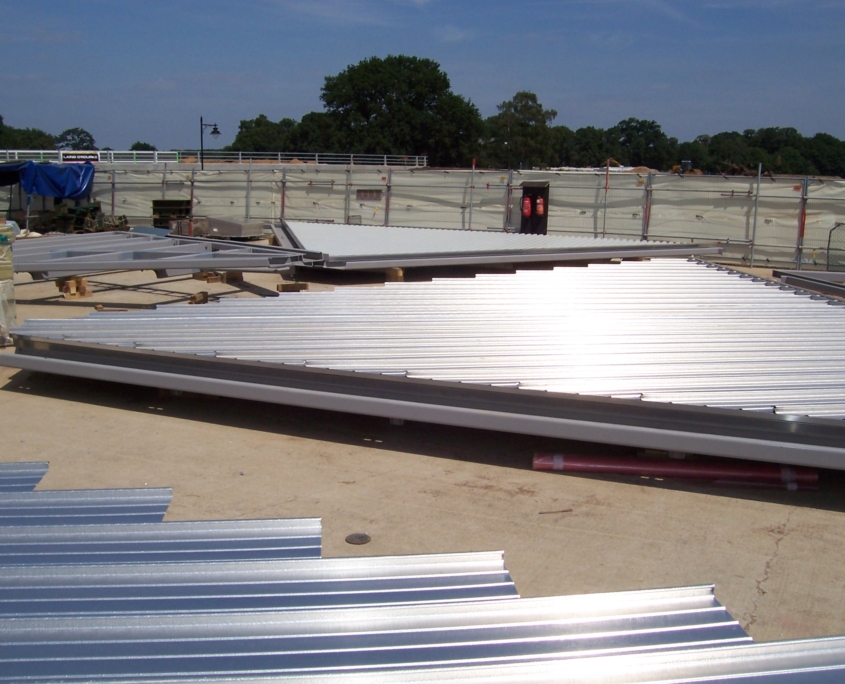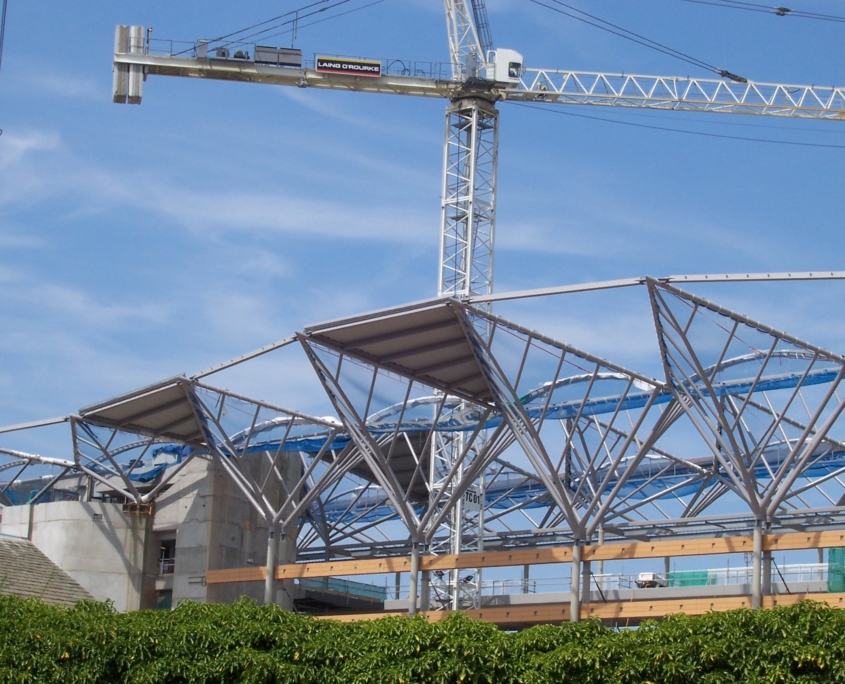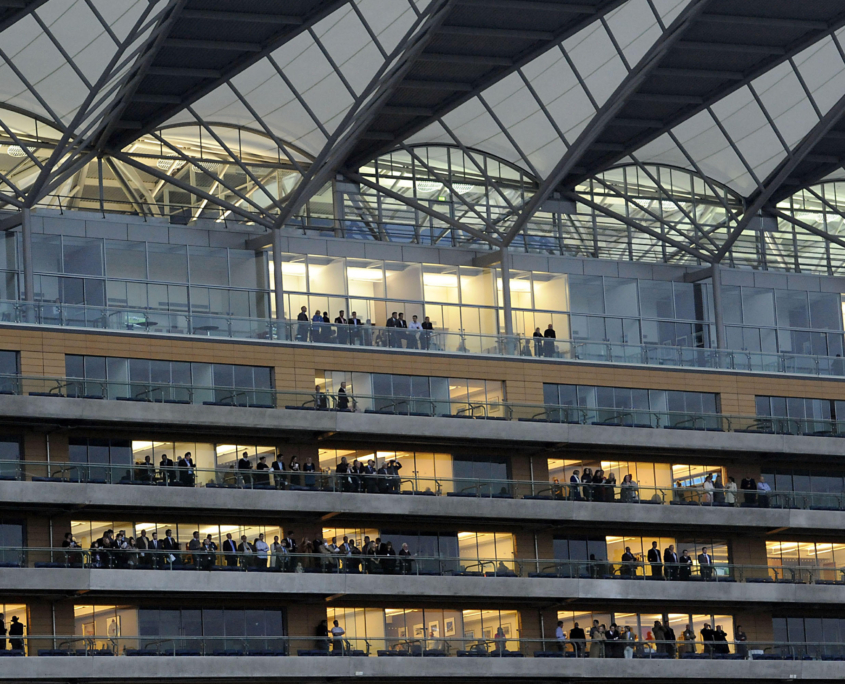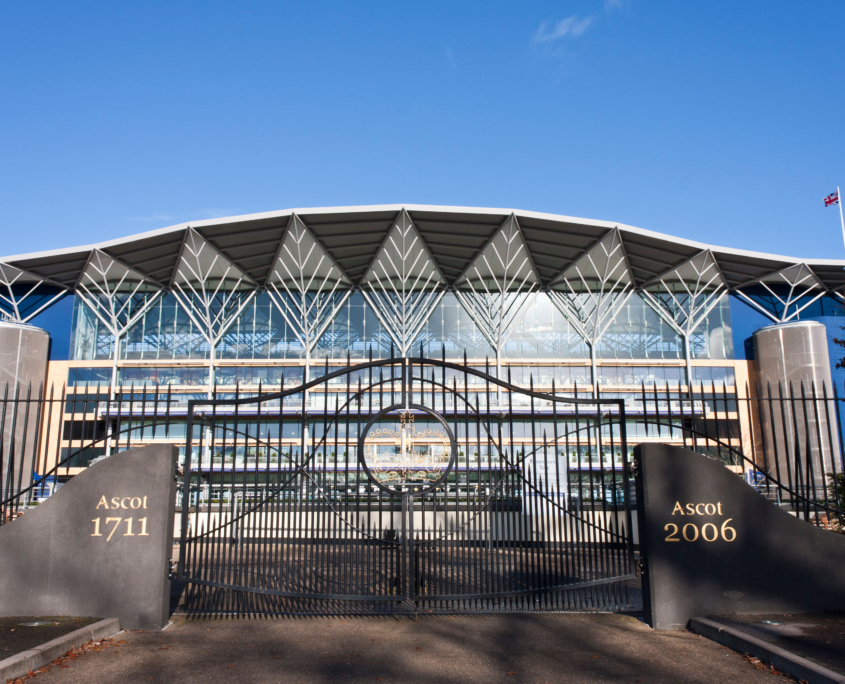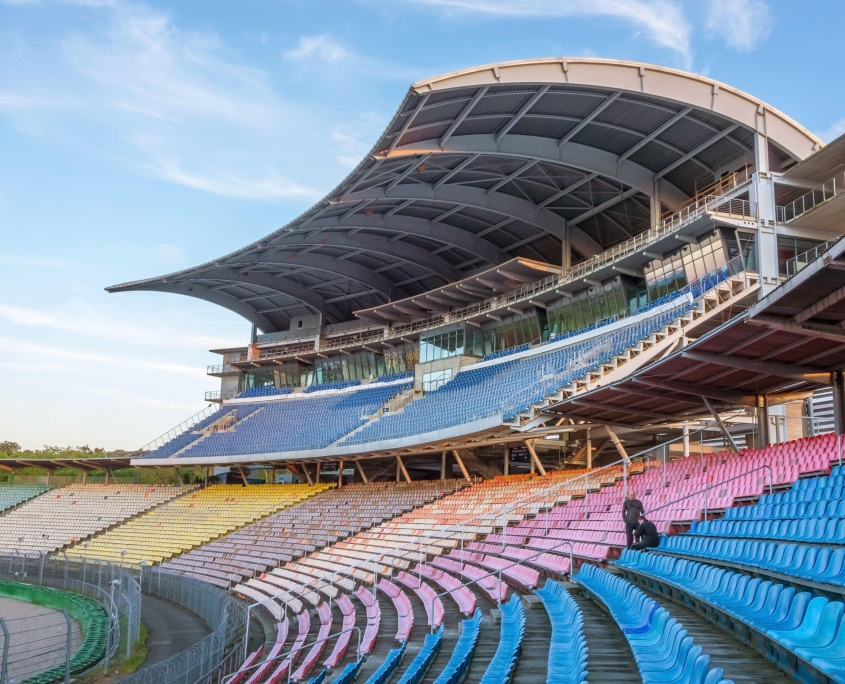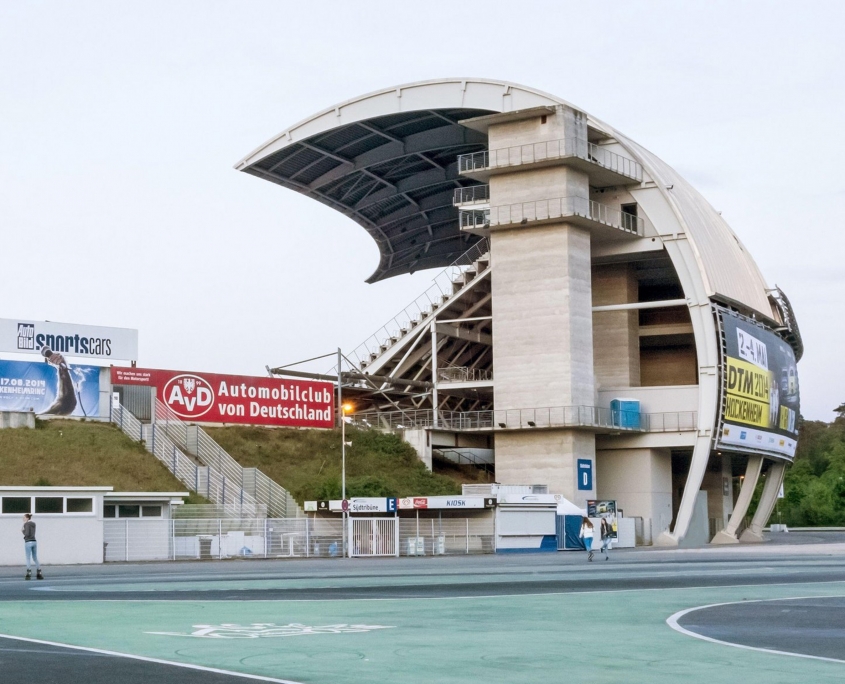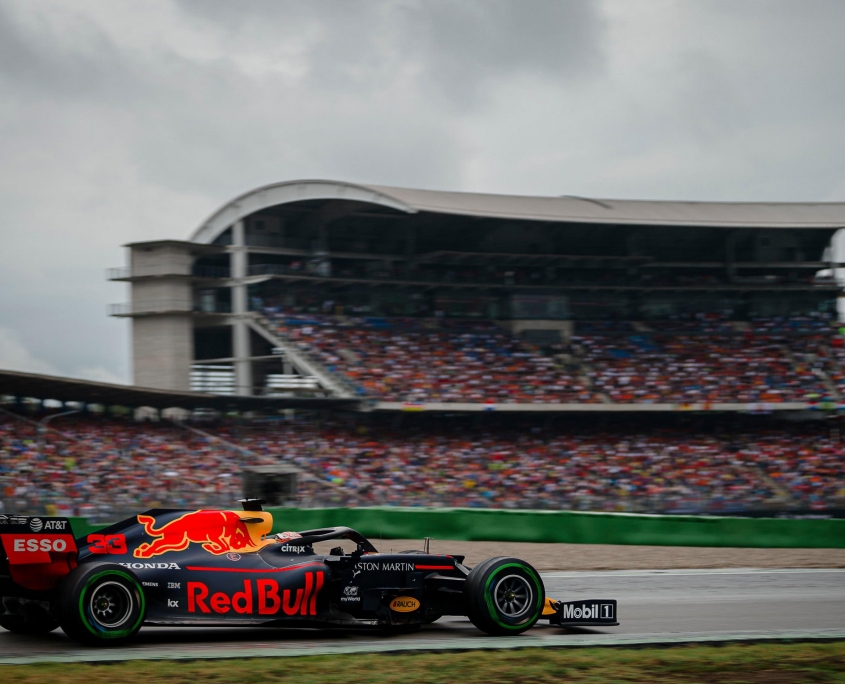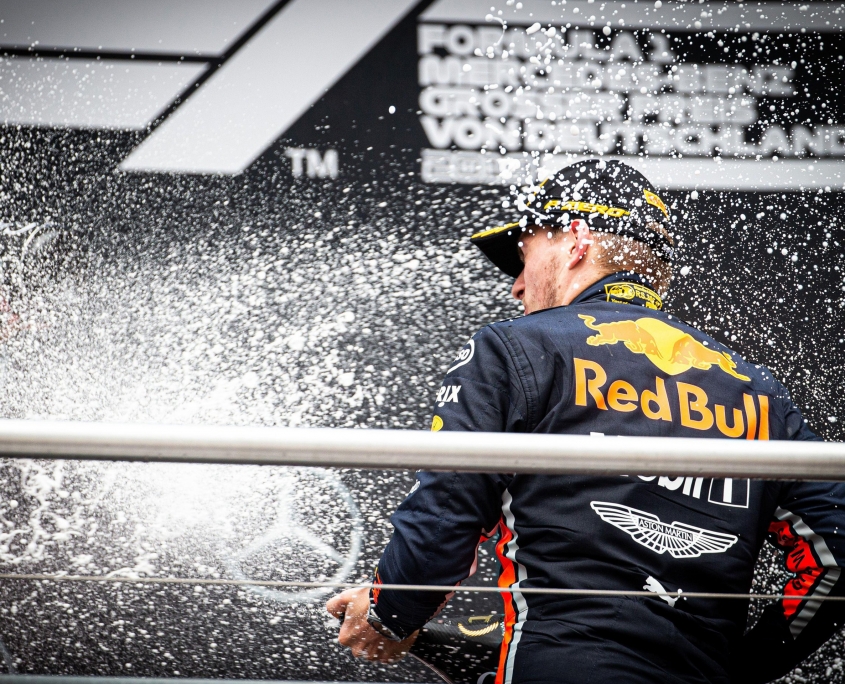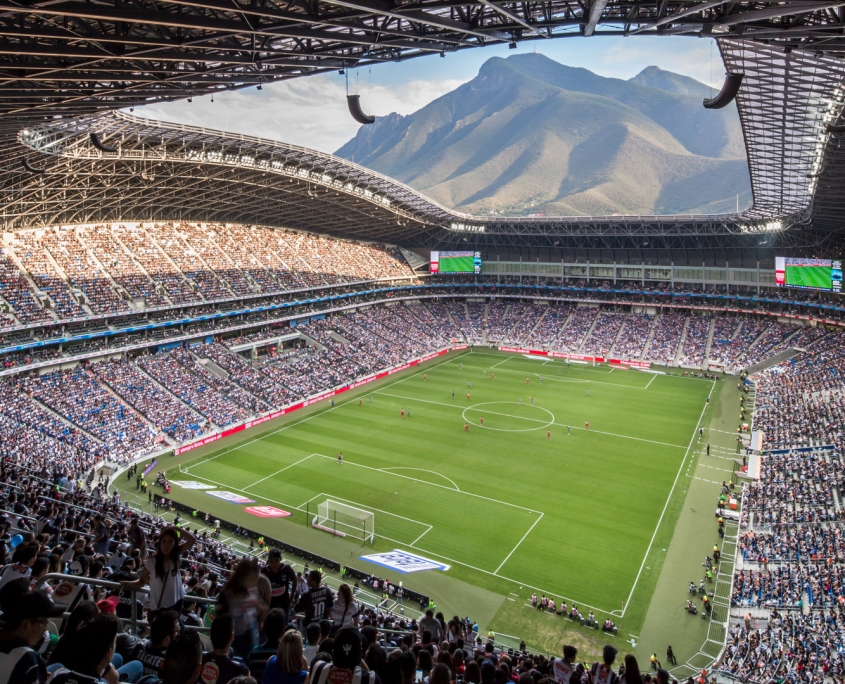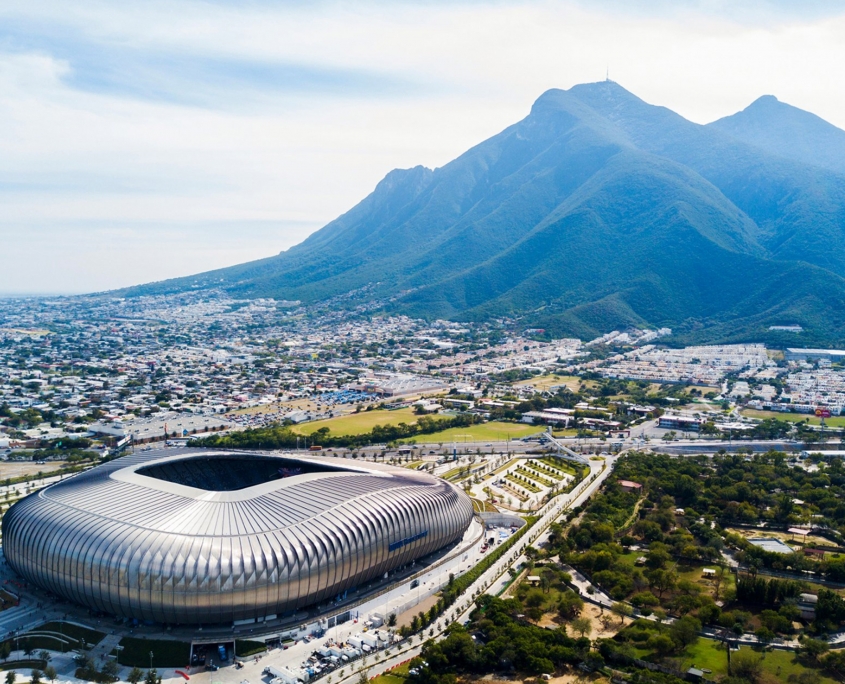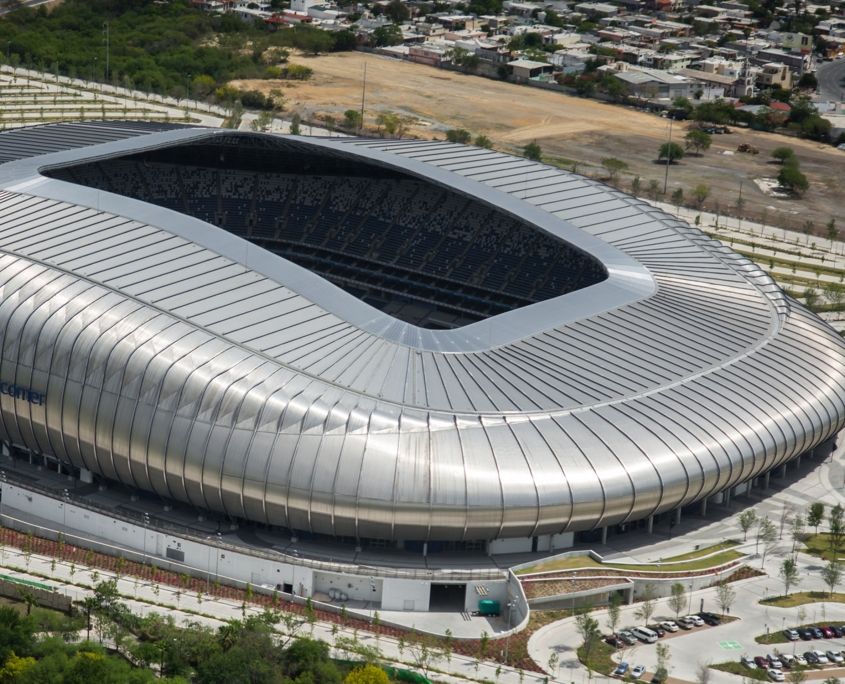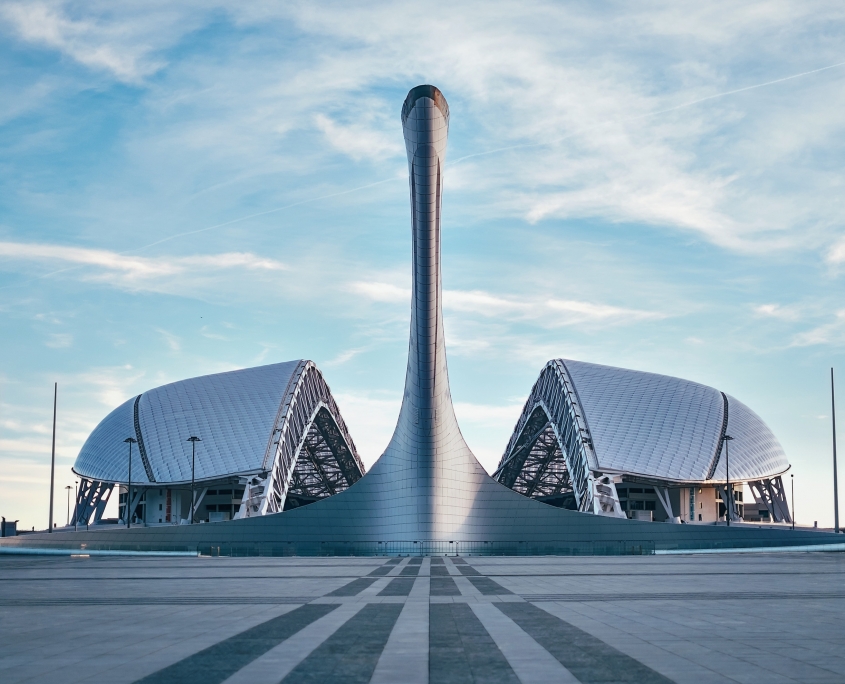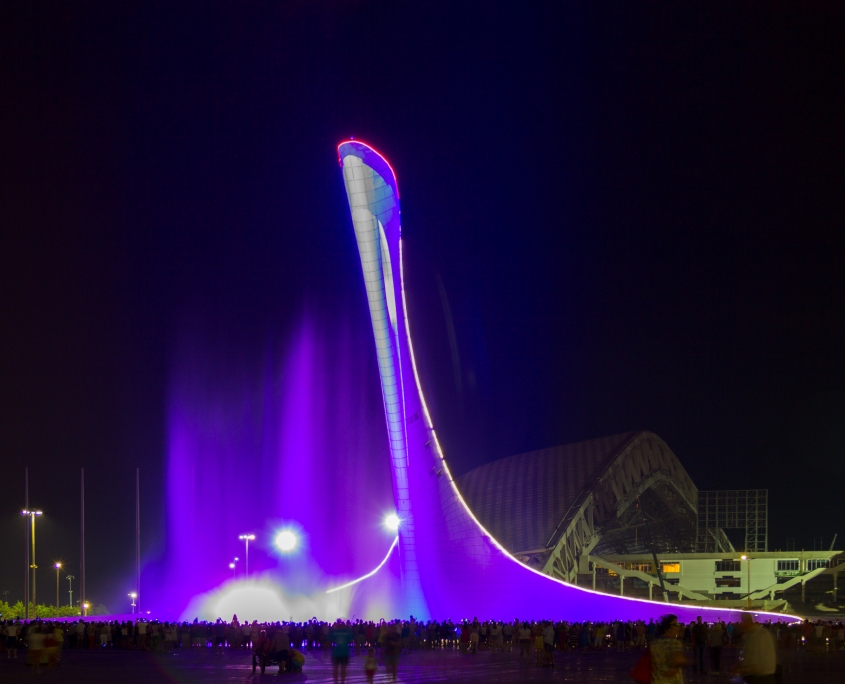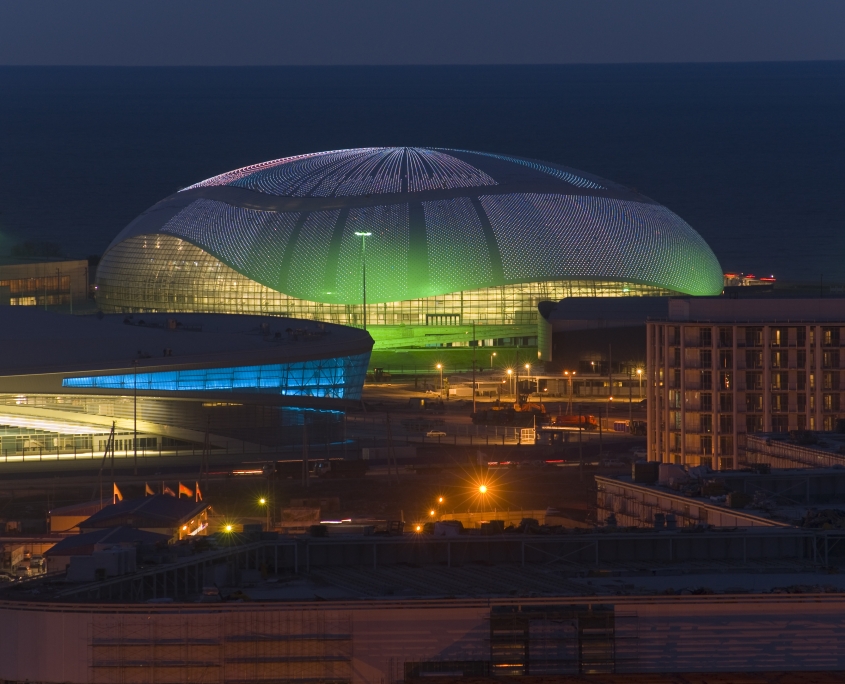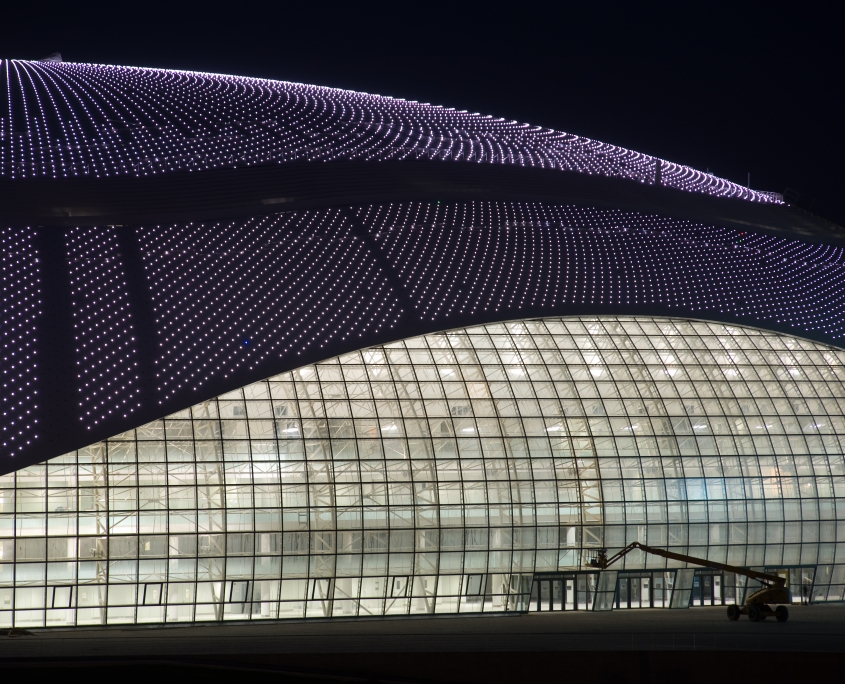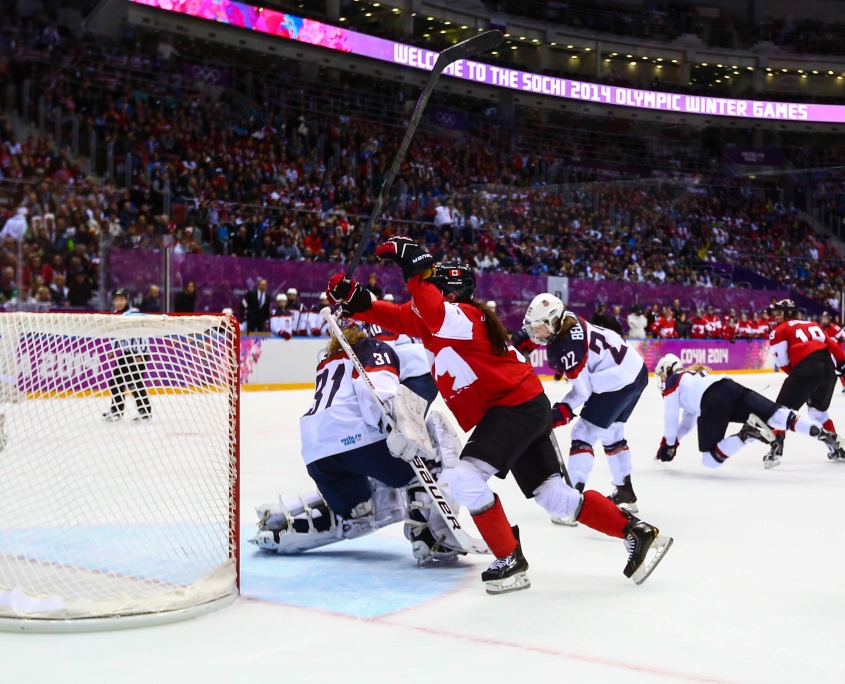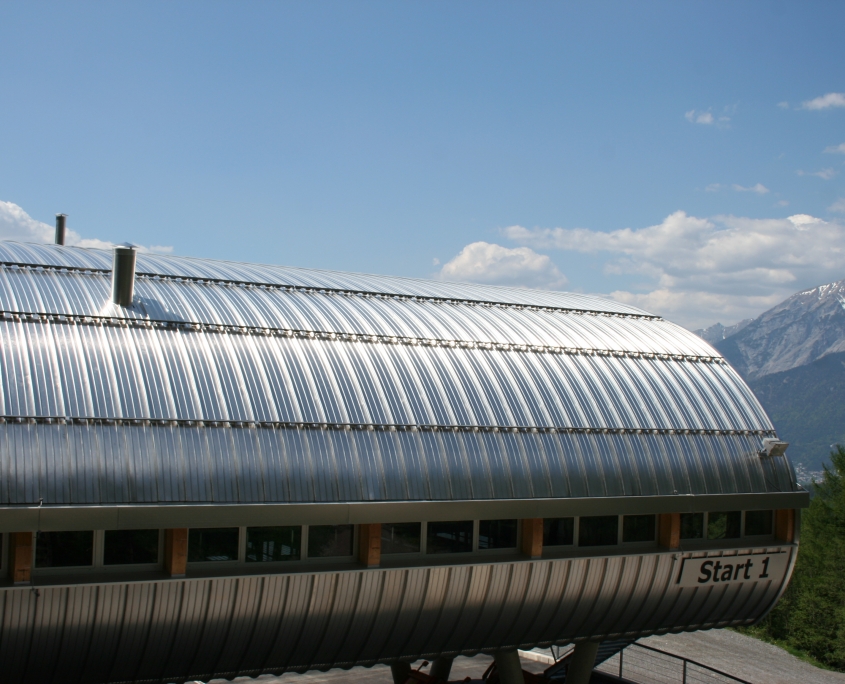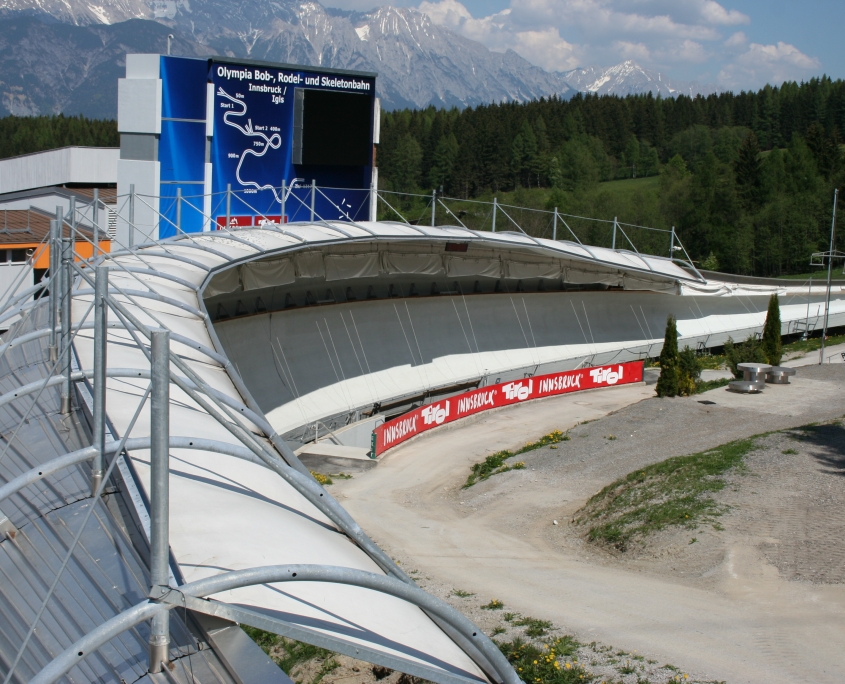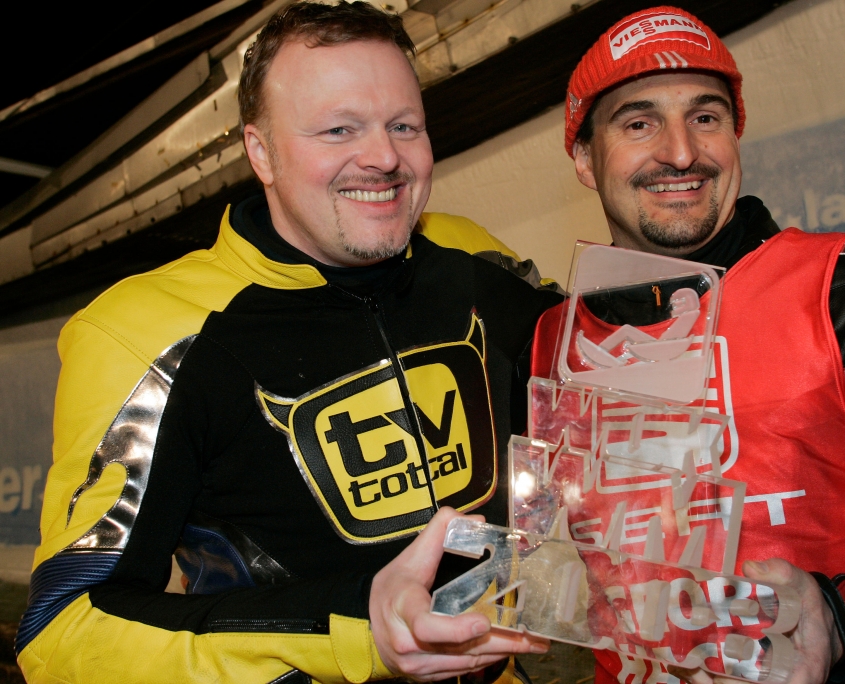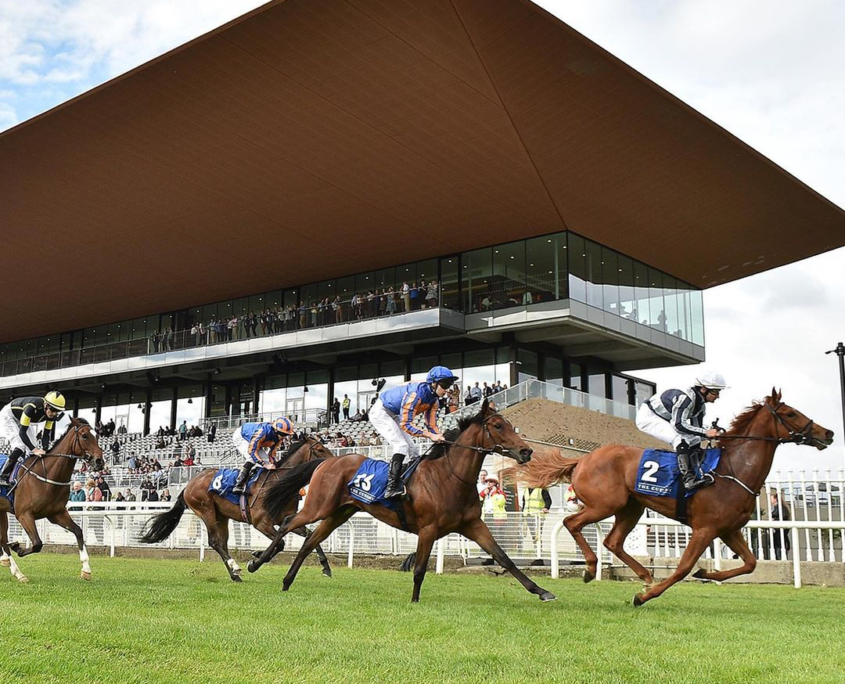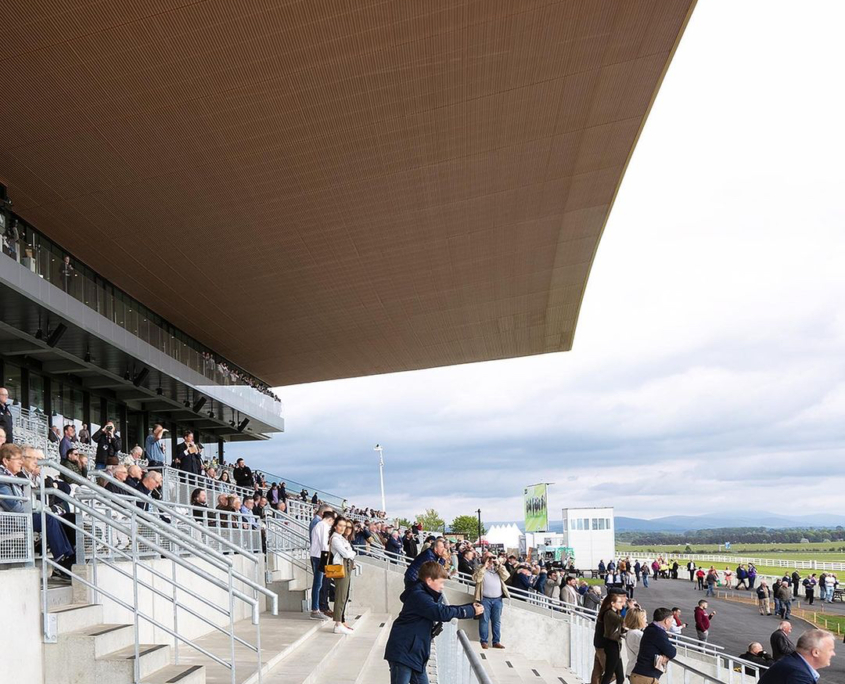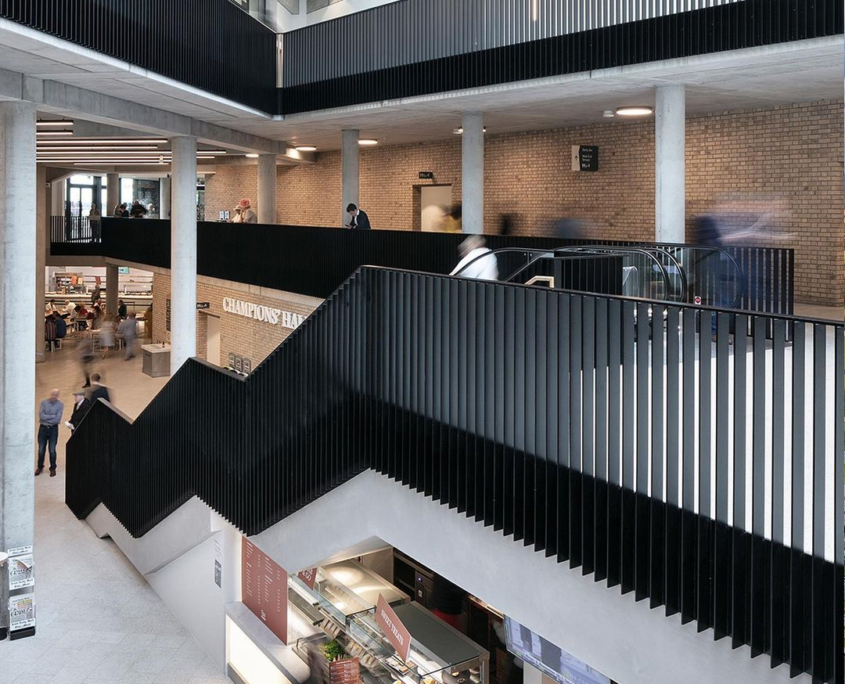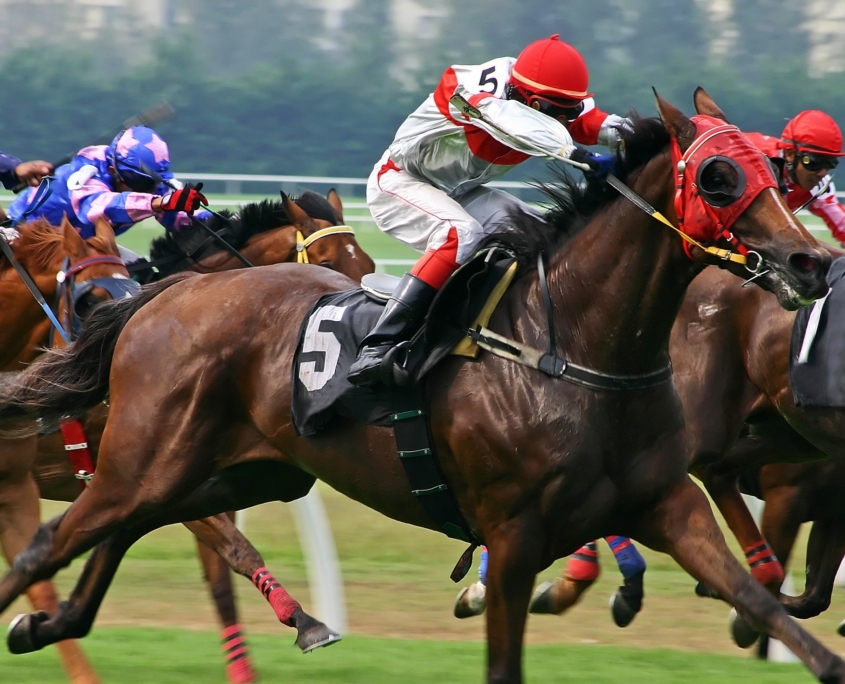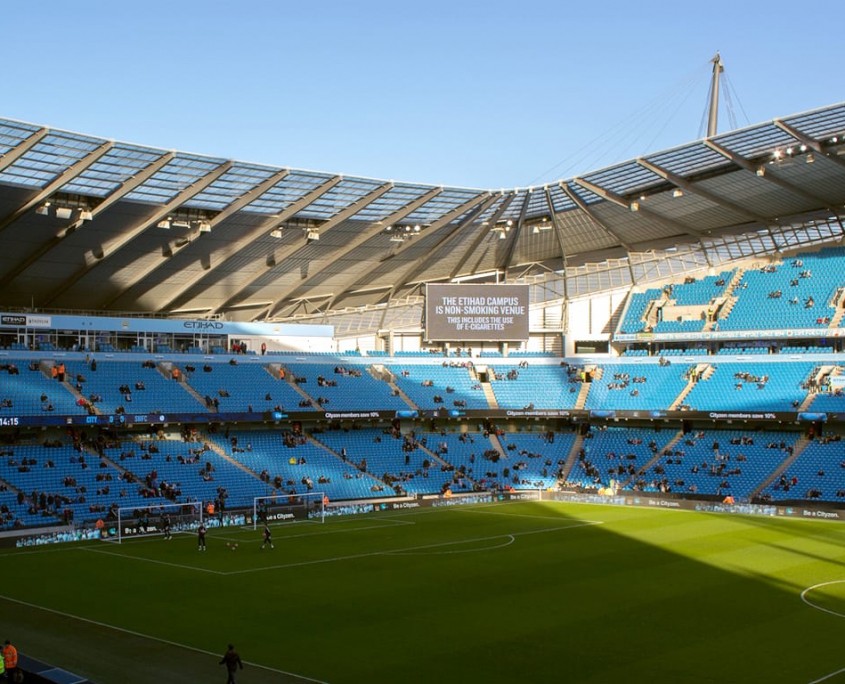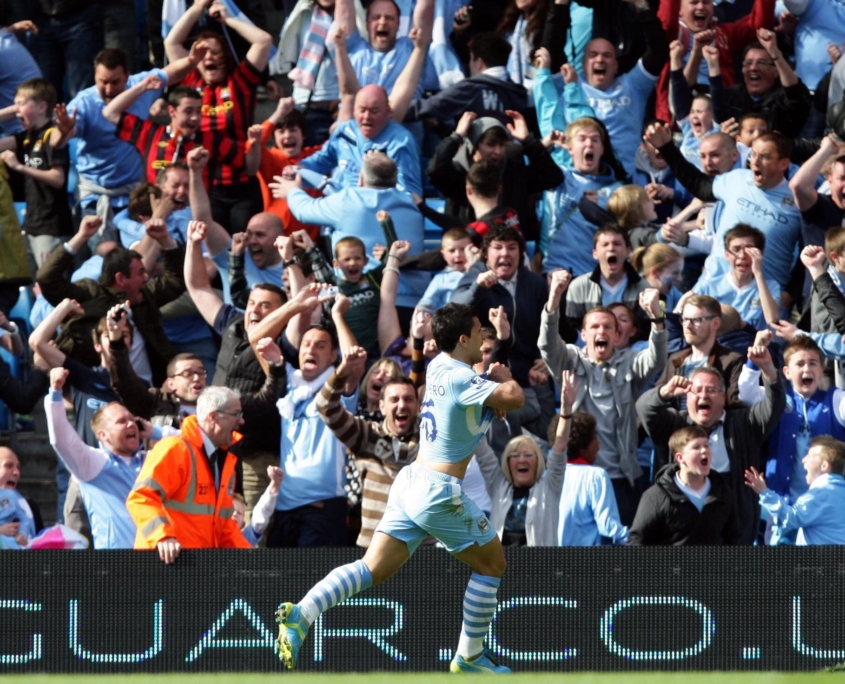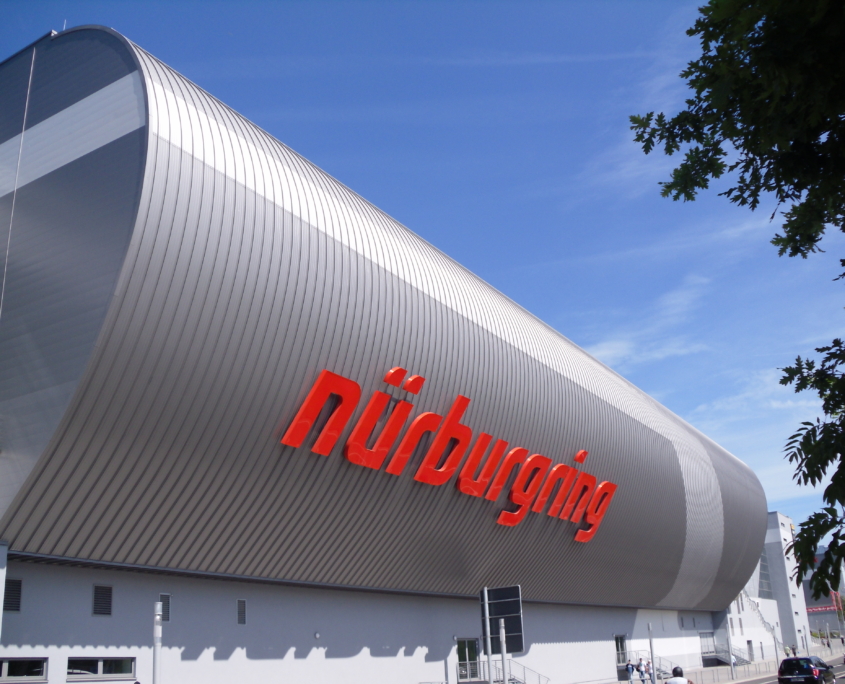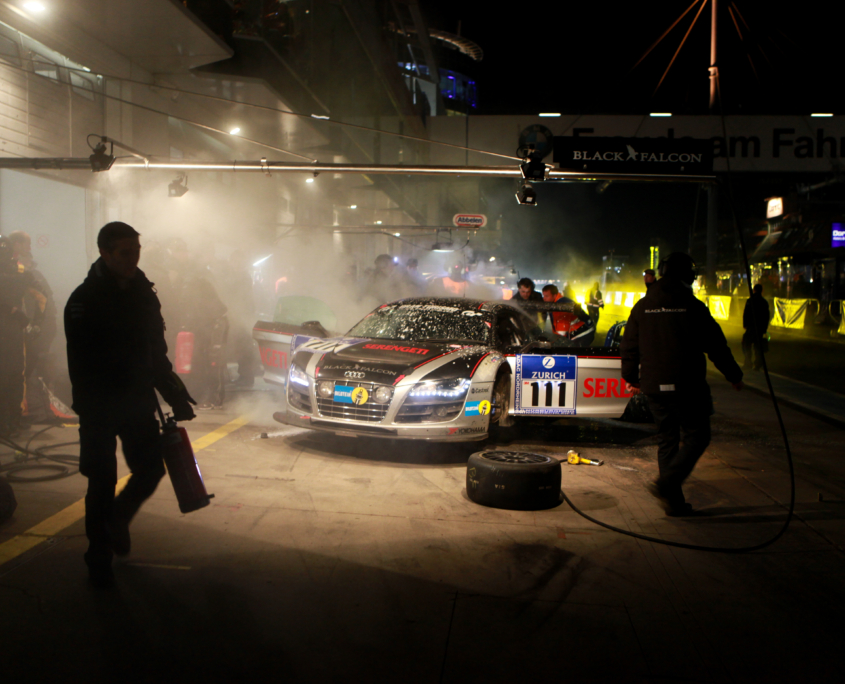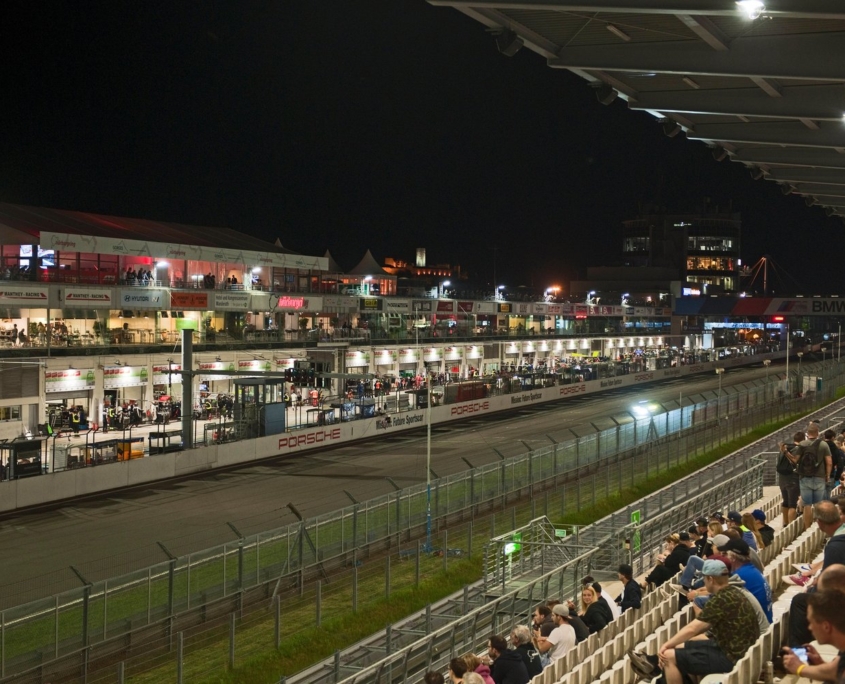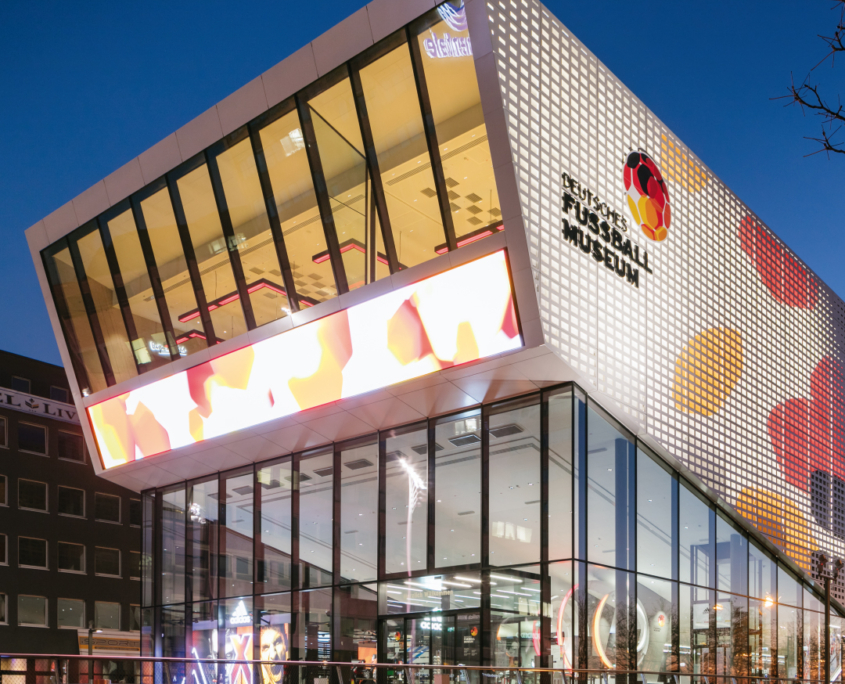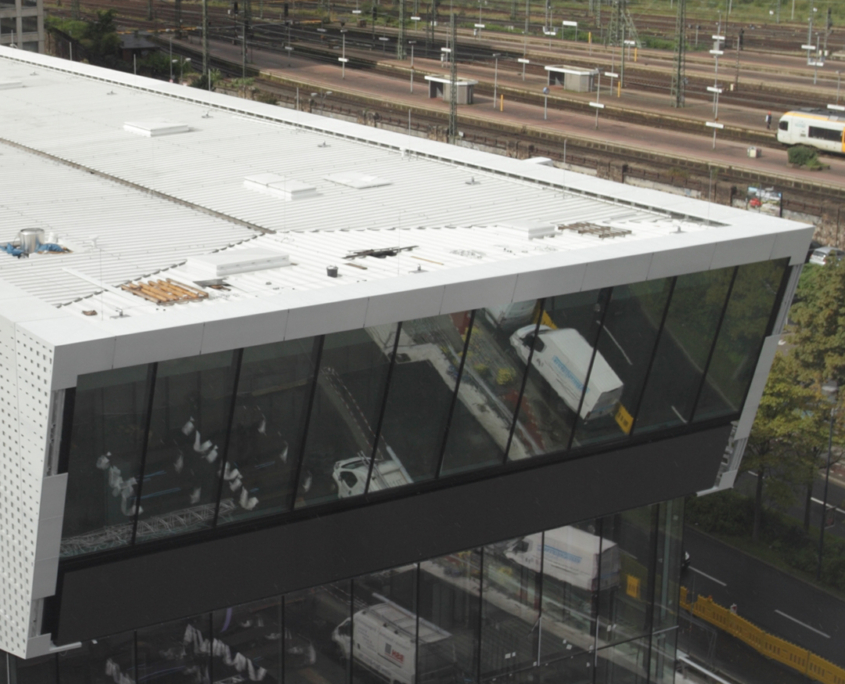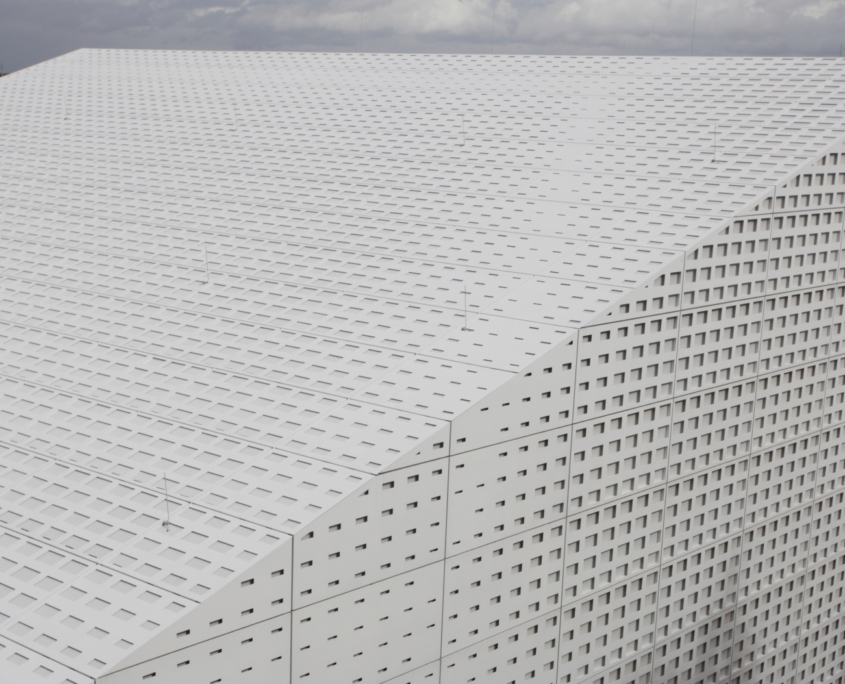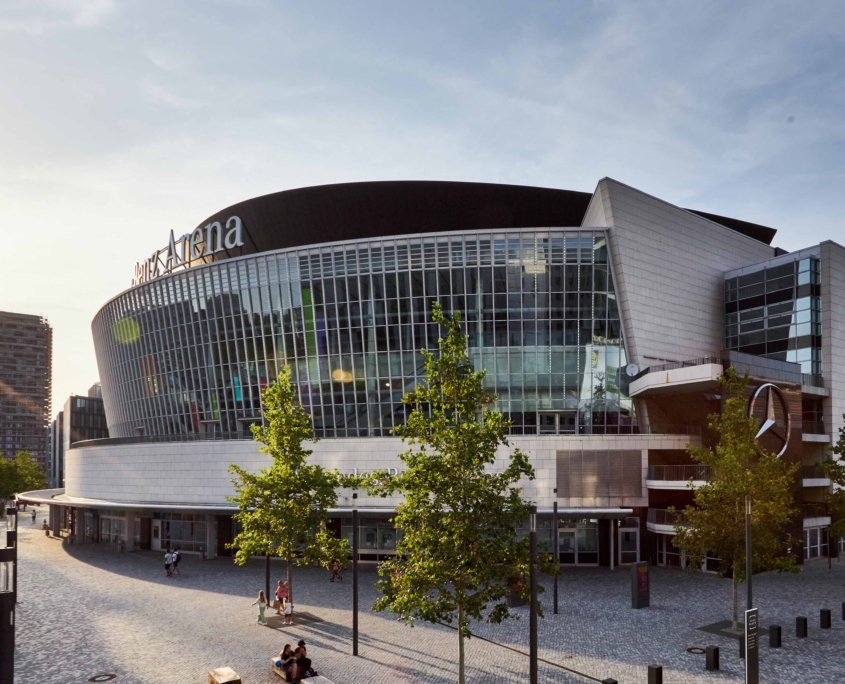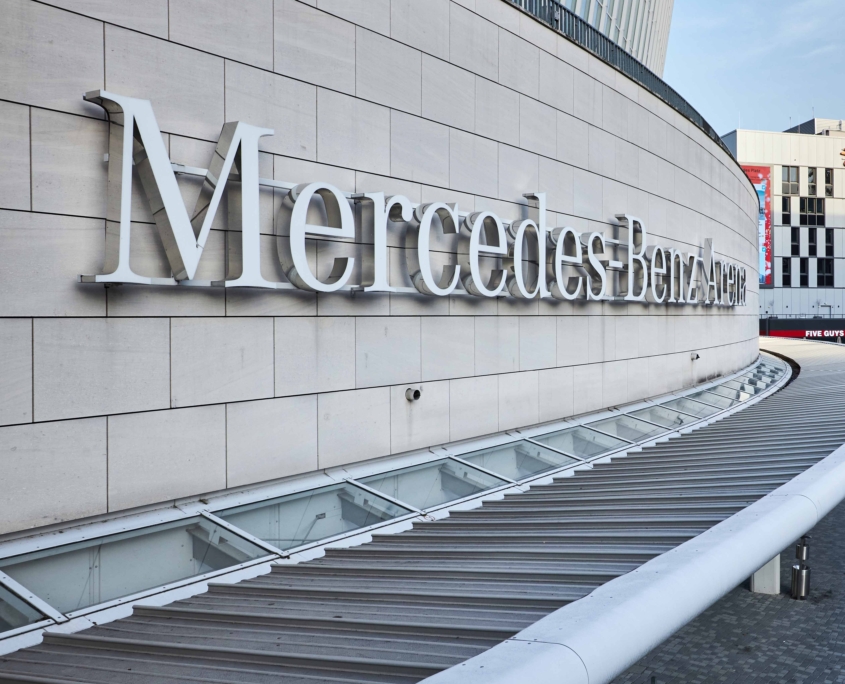It gets under our skin — knowing how many rousing sporting events take place under the roofs of the stadiums.
Above all, the strong emotions that are unleashed underneath. Boundless fighting spirit, the victory as a great goal in front of one’s eyes after years of sweaty preparation, respectful encounters between nations from all over the world, the euphoric cheering, the fans cheering along.
As long as the sport lives on in these stadiums, we will remain a part of it.
World Cup semi-final 1990 — A match for the history books
Home advantage in Turin:
How to score as an international company thanks to innovative production.
Germany defeats England in the classical match. Turin becomes a sea of black-red-gold jubilation in 1990, with a success in the Stadio Delle Alpi even before the final result after a penalty shoot-out.
The Stadio Delle Alpi in Turin made history in 1990. On the one hand as the venue for the classic football match between England and Germany, and on the other hand in Kalzip’s corporate history. This is because the 25,000 m2 aluminium roof construction we realised for the stadium was the first project in Europe to use a mobile roll former and the associated innovative on-site production — the second in the world.
The encounter between the two teams in the semi-finals was a real football drama that the German national team won in the legendary penalty shoot-out. Almost 22 million viewers and around 30,000 German fans in the stadium witnessed a real nail-biter.
Delle Alpi — a worthy venue
What few people know: There was already a German success in the Delle Alpi before that, because the roof construction we developed is a real feat in terms of architecture and statics and gave the stadium its striking silhouette.
The high-quality and extremely versatile material aluminium and the development competence Made by Kalzip are the reason why we, as the market leader, are able to demonstrate our competence in many international stadiums and sports facilities, among others. Because it is precisely in these construction projects that unusual shapes, enormous loads and static challenges are the order of the day. And that is precisely our discipline.
Home advantage on the construction site
As an international company and market leader, we made a phenomenon familiar to many from football our own thanks to an innovative manufacturing process we developed ourselves: Home advantage. For the first time in Europe, we produced the required standing seam profiled panels on site at the construction site. This meant that many logistical and technical requirements were extremely optimised and coordination processes were shortened. On-site production is a tactic that we still follow today for national and international buildings.
Perseverance, team spirit and success are factors that play an enormously important role not only in professional sport. In our construction projects, too, these are decisive qualities for optimal project execution. We prefer to leave excitement, passion and drama to the sporting duels.
Hoffenheim — Leverkusen: A goal, that changes a lot
A place for new technology:
PreZero Arena in Sinsheim brings innovations for stadium construction and sports
18 October 2013 will have a decisive significance in Bundesliga retrospectives for a long time. The stadium, which was only four years old at the time, experienced a historic moment.
Stefan Kießling, former German national player, scored the 2-0 goal in the match between Hoffenheim and Leverkusen. The scandal: The ball flew through a hole in the outer net and into the goal, paving the way for trend-setting rule changes in professional football. But Sinsheim was also the scene of technical innovations when the stadium was built.
PreZero Arena — a step to the future
Opened in 2009, the PreZero Arena is considered one of the most modern and attractive stadiums in Germany thanks to its aerial, bright architecture. The 30,150-seat arena was completed in just 24 months. A special highlight is the complex, three-dimensionally structured roof construction, which does not simply sit as a «lid» on the tiers but almost floats above the stands. The construction, consisting of 40,000 square metres of plastic membrane, is extremely filigree and weighs only 3,400 tonnes. We at Kalzip were able to play a decisive role in this engineering masterpiece and contribute to its success with our know-how in innovative manufacturing processes. The steel building underneath was also our first collaboration with Donges SteelTec — today a symbiosis under the roof of the Donges Group, which enables challenging constructions worldwide from a single source.
The small curved radii of the slim construction, which we were able to realise in this form for the first time by curving our X-Tail sheets, were particularly challenging in Sinsheim. The result of the special roof construction: the structure does not need any supporting pillars at all. For the spectators, this means that a clear and excellent view is guaranteed from all seats.
Best view — at least for the fans
This is how many fans see what had been missed by referee Felix Brych during the match between TSG Hoffenheim 1899 and Bayer 04 Leverkusen. Bayer striker Stefan Kießling heads the ball against the outer net in the 70th minute, but the ball flies through a hole in the net into the goal. Kießling, who already disappointedly turns away after his header, lets himself be infected by the goal celebration of his team mates. Referee Brych mistakenly calls a goal. The result: heated discussions and far-reaching consequences for football. The introduction of goal-line technology and video evidence can be seen as a direct reaction to this legendary phantom goal.
So Sinsheim is a place of change. The phantom goal has shown that even football, the most followed professional sport, is not perfect and can be constantly improved. Like us, the players involved in professional sport strive for regular optimisation in order to present a perfect result. The rule adjustments that are still in force today also characterise the fairness and team spirit of professional football — qualities that are also 100% lived in our work and taken to heart in every one of our construction projects.
The last step to the Superbowl 2010: A game heals wounds
Never give up!
The true meaning of the Caesars Superdome
New Orleans is the home of the Caesars Superdome, one of the most famous and iconic stadiums in the USA, with well over 70,000 spectators experiencing various superlative sporting events over the years.
But the Superdome is more than that: back in August 2005, despite a badly damaged roof due to Hurricane Katrina, the Superdome became the last place of refuge for over 30,000 evacuees and a symbol of hope. With the largest stadium refurbishment project in US history, Kalzip played a major role in shaping the history of the Superdome.
Caesars Superdome in New Orleans — last sanctuary for thousands
A stadium has many synonyms. For some it is their fortress, for others their temple, some even affectionately call it home. In 2005, these synonyms became a bitter reality for many US citizens, when Hurricane Katrina struck, New Orleans became the scene of one of the most devastating natural disasters in the history of the United States. Countless buildings were severely damaged and many people lost their homes. The Superdome — usually the venue for the New Orleans Saints football team plus numerous Super Bowl events and concerts — became the last refuge for over 30,000 people, and for many, the arena offered a last place of hope.
We don’t give up — the Superdome gets an innovative façade
The Superdome was also severely damaged by the hurricane. This was the starting point for a gigantic refurbishment project. True to the sporting motto «Never give up», all forces were combined. We are proud to have made a decisive contribution to this mammoth project with our technical expertise. It took only 13 months to reopen the Superdome after renovating the roof and the interior. Creativity was needed to restore the original appearance of the world’s largest dome and at the same time be prepared for extreme weather events. Kalzip developed our FC façade system, which sets new standards in the areas of flexibility, ease of installation and cost-effectiveness. This bi-directional facade system allows the aluminium panels to be installed from top to bottom and from bottom to top, as well as laterally in both directions. This functionality enabled us to remove the damaged façade and easily replace them with the Kalzip FC façade panels without affecting the overall appearance of the façade. At the same time, the clip connection ensures an extremely high wind load resistance for the façade. With approximately 34,000m² of the Kalzip FC Façade system installed, we have proven: We do not give up and embrace every challenge!
Only 5 years after Katrina:
The Saints send New Orleans into ecstasies
This spirit still has had a defining influence on the sporting events of the Superdome today. In 2009, it inspired the hometown New Orleans Saints to win their first NFC Championship Game against the Minnesota Vikings to reach the Super Bowl in Miami for the first time. They also won this game with a score of 31:17. On their return to New Orleans, the Saints were welcomed home by 70,000 enthusiastic fans.
This story that underlines the importance of sport for the people of the city. Sport brings people together and helps them to put bad events behind them. In sport, too, there are often setbacks and serious disappointments, but these only make athletes and fans stronger. At Kalzip we share this passion, because even in difficult times, there is only one thing to do: stand up, tackle and above all: never give up!
Olympics 2021 in London — faster, higher, stronger
The right technique as a prerequisite for the perfect wave
Exactly one year before the opening of the 2012 London Olympics, the time had come: The London Aquatics Centre was opened as the central venue for the six swimming disciplines. True to the Olympic motto «Faster, Higher, Stronger», the completion of the aquatics arena located in the Queen Elizabeth Olympic Park was also a world-class achievement.
The focus of the Olympics is on the athletes. They compete for Olympic gold in over 300 competitions. The fascination of the Olympics is to achieve the best performance through pure will, dedication and passion. At the same time, it is an incredible challenge that must be overcome. With the award of the construction contract for the roof of the Aquatics Centre, Kalzip were also played their part in this festival of sport.
Kalzip on the Olympic path
London 2012 was calling, and we were ready. Our planning for the 2012 Summer Olympics was not unlike that of a top athlete. Participation in the Olympic Games requires long and detailed preparation. If you want to take part, you have to train intensively and constantly improve. Hurdles have to be overcome and boundaries crossed.
Only the best reach the finish line and see the Olympic flame. To be at the top, you need the greatest fighting spirit and the best technique. While the best swimmers in the world worked intensively on their technique and condition, it was up to Kalzip to present them with the best possible venue.
Triumph after long and intensive preparation
This would not have been possible without perfect preparation. Absolute precision was taken into account right from the initial planning stage. With the help our innovative 3D design technology, the complex roof construction was conceived to guarantee one hundred percent accuracy in both the manufacturing and installation process. The was carried out using our flexible Kalzip XT system, which allows be-spoke roof shapes to become a reality. Our roof stands out as a key design element on the 160m long, 80m wide and 45m high facility.
The design is based on the specific characteristics of water sports and visually showcases the water sports arena in all its glory. Thus, the wave-shaped roof geometry approx. 1040m² was inspired by the idea of a swimmer breaking through the water. Zaha Hadid served as the lead architect for the project. In 2004, she became the first woman to receive the Pritzker Prize, the world’s most prestigious architectural award. Her kinetic architectural style is perfectly reflected in the flowing wave of the London Aquatics Centre, making the architect, who died in 2016, immortal to this day.
«Inspiring a Generation»
The legacy the 2012 London Olympics epitomises our approach not to rest on our laurels, but to continuously improve and strive for the best possible performance. As an Olympic role model the US swimmer Michael Phelps, despite several Olympic victories in 2004 and 2008, at the 2012 ‘games’ Phelps became the most successful athlete at the games with four gold and two silver medals. With a total of 23 gold medals won in total, he truly inspired an entire generation. We are proud to be part of this inspiration and can’t wait to create more fascination with our future building projects.
Royal Ascot Racecourse: Meeting point for high society
Venue with a royal past and presence
Founded by Queen Anne in 1711, Ascot Racecourse is still one of the absolute highlights of British equestrian sport.
Queen Anne discovered the unused piece of land when, on a ride from Windsor Castle, she came across an area of open moorland that she said was «ideal for horses at full gallop». Her plans for a new racecourse were then announced in the London Gazette of 12 July 1711.
Royal presence captivates viewers
Ascot Racecourse is visited by around 600,000 people a year, representing 10% of all racegoers in the UK. The racecourse covers an area of 72 hectares leased from the Crown Estate and is closely associated with the British royal family and about 9.7 km from Windsor Castle. Even Queen Elizabeth II visits Ascot several times a year.
Horse racing all year long
Ascot currently hosts 26 racing days a year, including 18 flat races between April and October and 8 jump races between October and March. The Royal Meeting, held every June, remains the highlight of the British summer calendar. The prestigious King George VI and Queen Elizabeth Stakes is held at the racecourse in July.
Royal work by Kalzip
The new Grand Stand is 260 metres long and up to 60 metres wide. It was built in 2004 as part of a large-scale refurbishment. The new grandstand has both a transparent glass façade and a complex curved roof, in which Kalzip played a major role. A special feature of the grandstand is that the roof, made of individual Kalzip components, cantilevers out over the grandstand by up to 21 metres.
However, the tight schedule presented both the architects from HOK Sports Venue, the structural planning from the Happold office and the installers from the company B. Schlichter GmbH & Co. KG from the Heppenheim site, which required intensive cooperation and creative solutions. But Kalzip was able to draw on existing technologies. For the roof structure, trapezoidal profile supporting shells made of aluminium were used, which formed the substructure for the sliding wing roof. The vapour barrier lies on top of this. The roof structure was finished off with the Kalzip profile type 50/429/0.9. The roof elements installed were between 30 and 130 m2 in size, while the steel construction parts even weighed up to 15 tonnes.
Whether equestrian sport or a tight schedule, we at Kalzip have mastered every challenge and look forward to helping sports facilities around the world to shine again in the future.
Südtribüne Hockenheimring — a racetrack at the pulse of time
Südtribüne Hockenheim — A view of a legendary race track as well as an impressive event location
Located south of Mannheim, the Hockenheimring is a world-famous and highly regarded motorsport circuit. Formula 1 greats such as Michael Schumacher and Lewis Hamilton have impressed spectators here with spectacular performances. The south grandstand provides the perfect view. Under the spectacular Kalzip roof, the spectators are part of the action even in heavy rain. Open airs remain just as unforgettable as the Mercedes debacle of 2019.
From the first motorbike race in 1932 to the construction of the Motodrom in the 1960s and, for the time being, the last Formula 1 race on German soil in 2019 — the Hockenheimring has shaped various generations and turned spectators into frenetic motorsport fans. Formula 1 came to Hockenheim for the first time in 1970. Over 100,000 spectators witnessed the victory of the tragic Formula 1 legend Jochen Rindt. To this day, he is the only world champion who was awarded the title posthumously due to a fatal accident in Monza one month later.
Less track, increased racing feeling — massive south grandstand thanks to Kalzip
Until 2001, the course was 6.8 kilometres long. Large sections were driven through the forest and were therefore not visible to the spectators. The attractiveness of the track for both drivers and spectators was increased enormously through renovation measures to the tune of around 62 million euros. Today’s well-known 4.5km race track guarantees exciting overtaking manoeuvres with its tight combinations of bends. The best view is from the south grandstand, which is located at the height of the start/finish straight. The structure, built in 2003 by Kalzip and Schüngel Metal Systems GmbH, offers an impressive view of the world-famous Motodrom. The process of creating the structure was also impressive, as the curved Kalzip profiled sheets had to be attached to the façade. The roof and façade thus merged into one — a challenge that was demonstrably mastered.
Rain chaos at Verstappen’s 2019 triumph
Weather conditions can have a decisive influence on a Formula 1 race. Unpredictable rainfall in particular makes for spectacular racing events. This is what happened at the last German Grand Prix to date. Four safety car phases were necessary due to various spins and accidents. Due to the clever choice of tyres, it was Max Verstappen in the Red Bull who took the day’s victory. The man of the day, however, was Sebastian Vettel. Starting from 20th place, he finished the day in 2nd place after a very strong performance. The Mercedes drivers Lewis Hamilton and Valtteri Bottas, on the other hand, put negative exclamation marks on the day. Botched pit stops, time penalties and driving errors resulted in a lot of frustration and no points.
The spectators were able to watch this rain battle from dry ground thanks to Kalzip. The roof of the 30m-high south grandstand merges directly into the façade and, with its roller-rounded tracks, ensures not only an iconic design but also racing enjoyment in all weathers.
Hockenheim continues to host special events — DTM finale in October
However, it is not only the top class of motorsport that provides emotions. True to the motto «More than Racing», the Hockenheimring is particularly versatile when it comes to concerts. Whether AC/DC or Ed Sheeran — hundreds of thousands of fans are always thrilled. But you can’t do without the roots
Estadio BBVA Bancomer — Home of latin american football-dreams
La pasión del fútbol – Kalzip works in Mexico for the first time
If you are looking for passionate football fans, you will quickly find them in Mexico. In the Estadio BBVA formerly known as the Estadio BBVA Bancomer, the home ground of CF Monterrey, up to 53,500 spectators often celebrate a football festival.
It quickly becomes clear that the distance between the pitch and the stands is limited to the minimum set by FIFA. The direct experience of the game as well as the impressive construction of the Kalzip® standing seam roof have shaped the Latin American football landscape since the opening in 2015.
The Steel Giant
With a size of 277×232 metres and a circumference of 800 metres, it is understandable why the stadium is also called «El Gigante de Acero» (Engl.: The Steel Giant). The imposing sight is further enhanced by the mountain views in the background. Without the vision of the Architectural firms Populous together with the Mexican firm VFO, this realisation would not have been possible. A look at the hot and unpredictable climate of the region underlines that not only do the players of the local CF Monterrey face challenges, but also all those involved in the construction process.
Despite all challenges — Kalzip impresses with quality and performance
The weather conditions typical for the region, such as wind, heavy rain and strongly fluctuating temperatures, had to be considered in the initial planning and design. With the Kalzip® aluminium standing seam roof system, we were quickly able to offer a solution for the 51,000m² roof*. Thanks to our patented clip system, our roofs can easily withstand the given climatic conditions as well as comprehensively meet the highest safety requirements.
Within the construction period of just under four years, we delivered more than 40 containers in 16 shipments and built our own production yard on site. Since our range and material offer limitless design potential, the architects were able to give free rein to their vision. The result: a design that reflects both the history of the region and the mountainous landscape, but also a sustainable design, as the Estadio BBVA received a silver certificate from the Leadership in Energy and Environmental Design [LEED] organisation.
*The stadium was opened in 2015 with a capacity of 51,000 people, making it the fourth largest in Mexico. The owners soon added more seats, expanding the capacity to 53,500 in 2016
Commitment up to the last minute
The Club de Fútbol Monterrey, one of Mexico’s most traditional clubs, plays its home games in the Estadio BBVA. A club which, in keeping with the construction of the stadium, defies every challenge. This is what happened in the first match in the new stadium on 11 August 2015, when the team was already trailing 0-2 after 25 minutes against CF Pachuca. With will, passion and the cheers of the crowd, the game was turned around in the 63rd minute. Even when they conceded another goal to equalise 3-3 in the 69th minute, the home side could not be stopped. Supported by the fans and with the irrepressible striving for success, they scored the winning goal in the last minute to make it 4-3. There could not have been a more spectacular first home game.
With this attitude, the club celebrated the greatest success in the club’s history in 2019. The second leg of the 2019 CONCACAF Champions League final was played at home. After a 1-0 win in the first leg, and with a 1-1 draw in the second leg Monterrey won the final 2-1 on aggregate.
«El Gigante de Acero» finally became a football temple — also thanks to Kalzip.
Olympic parc in Sochi — Let the games begin
Kalzip ignites 2014 Winter Olympics in Sochi
What are the Olympic Games without the opening by the Olympic flame — at least not the one you look forward to for two years? Kalzip thought so too and played a major role in lighting the torch at the 2014 Winter Games in Sochi.
Olympic Torch Relay into Space
The torch relay of the Winter Olympics in Sotchi lasted 123 days and 65,000 kilometres. In the process, 14,000 runners carried the torch from Olympia in Greece, via cities such as Athens, Moscow, Saint Petersburg, and many more, to the destination of Sotchi.
However, the Olympic torch did not stop at the borders of the earth. On 7 November 2013, the torch without fire was also flown to the ISS on a Soyuz rocket. There it was carried into free space for the first time. Two months later, on 7 February 2014, the Olympic flame was ceremoniously lit by former figure skater Irina Rodnina and former ice hockey player Vladislav Tretyak.
Visitors and athletes do not even notice the solved last minute problems and can enjoy a fantastic opening ceremony.
A moment of shock just before the opening
Kalzip had the task of supplying the so-called composite panels, the molded sheets of cladding for the tower that is being erected in the middle of Medals Plaza. But we were faced with completely different challenges just days before the grand opening. During heavy storms, the monument with its slender structure and difficult geometric shape began to vibrate in such a way that it was shaken in its stability.
However, Kalzip also faced this problem. We, therefore, used our good contacts in the German engineering community and engaged the Institute for Steel Construction and Light Metal Construction RWTH Aachen in an advisory capacity. And the calculated solution to the problem showed the promised effect: three dynamic vibration dampers, each weighing 600 kilograms, which were transported to Russia in no time at all and then installed inside the torch. So nothing could stand in the way of the opening of the Winter Games.
Kalzip shows that even under time pressure they are capable of designing innovative solutions for near and far. Because you can rely on us. This is demonstrated not only by this project in Sotchi but also by our numerous participation in sports facilities worldwide.
Ice Dome Bolshoy — Double hockey gold for Canada
A sports facility of the modern age — Kalzip helps to create Olympic splendor
Planned by the architect SIC Mostovik, the Ice Dome Bolshoy in Sochi also offers space for many sporting events around the Olympics. In the run-up to the 2014 Olympic Games, for example, the Ice Palace was the venue for the World Under-18 Ice Hockey Championship in April 2013.
The Bolshoy Ice Dome was completed in 2012 and seats up to 12,000 spectators. Originally built for the 2014 Olympic ice hockey tournaments, the Ice Arena has also been the home ground for HK Sotchi from the Continental Hockey Liga since the 2014/15 season and regularly functions as a concert venue for music enthusiasts.
A real multicomplex
The ice dome building consists of two heads that perfectly harmonise technology and entertainment. The building has a complex shape, which made the implementation phase a real challenge. The most important sculptural accent is the combination of the shimmering, glossy surface of the cover and the stained glass window, which reflects the surroundings. The stylobate, designed as a low, sloping hill with a height of 8 metres, contains zones under the hall with changing rooms for the athletes, a training arena, a press centre, a catering area, technical support facilities, and a circular access road intended for the loading and loading area of the VIP areas.
Kalzip turns vision into reality
We at Kalzip were significantly involved in the creation of this structure through the external cladding, which had to overcome the challenge of a sloping concrete substructure, among other challenges. The roof of the Ice Dome is a domed dome roof consisting of convex curved and X-tail Kalzip aluminium profiles. The main arena was spanned with steel trusses supported by a reinforced concrete wall. The roof and façade cladding is based on the Kalzip additive system, with a water-repellent layer and a decorative layer on top. The pearlescent roof panels in combination with the multi-coloured glass system thus create a bright and rich image of a modern sports facility with the best functionality.
It is not only sporting competitions that are characterised by excitement. Kalzip has also been working on exciting projects for more than 50 years and embellishes the roofs and facades of the world with versatile aluminium constructions.
Dramatic finish in the final
In addition to its modern architecture, the Ice Dome also boasts exciting sporting competitions. During the 2014 Winter Games, it witnessed high-class games and dramatic decisions in the ice hockey competitions inside. One of the absolute highlights was the women’s final.
In what has already become a classic match between the USA and Canada, the favourites from the North looked like the clear losers for a long time. The US women led 2:0 and even survived a 3:5 shorthanded period in the second period without conceding a goal. But in a turbulent final phase, Canada managed to tie the game up and even score the equalizer in the last minute.
Double strike ensures the decision
It got even better for the acclaimed equalizer: in the 9th minute of overtime, Marie-Philip Poulin ensured the Canadian victory and unbridled cheers in the arena.
At the end of the tournament, the Canadian men’s team also did the same to their colleagues and ensured double gold for Canada in the ice hockey events.
With this attitude, the club celebrated the greatest success in the club’s history in 2019. The second leg of the 2019 CONCACAF Champions League final was played at home. After a 1-0 win in the first leg, and with a 1-1 draw in the second leg Monterrey won the final 2-1 on aggregate.
«El Gigante de Acero» finally became a football temple — also thanks to Kalzip.
Olympic ice channel in Innsbruck Igls — Experience winter sports yourself
The start into a fast-paced world
Flat or straight downhill — these 2 options are available to start the rapid downhill run on the Innsbruck Igls artificial ice bobsleigh track. Both starts are possible from the aluminium cladded starting house. With the modernisation of the bobsleigh track in 2006, the starting house was also modernised to the latest technical standards. This makes the ice course one of the most modern in the world.
When Olympic athletes plunged into the Innsbruck Igls ice track in 1976 for the second time since 1964, they did so on the world’s most modern facility. And the Olympic World track still has this claim, which is why the facility is regularly modernised.
Winter sports according to the highest international standards
It is a whole 1,270 metres from the men’s start through 14 curves and a roundabout to the finish. As one of less than 20 facilities worldwide, the Olympic track offers the conditions for international competitions in luge, bobsleigh, and skeleton. And it is also ideally equipped for the future, because the ice canal is the only artificial ice bobsleigh track in Austria, and has been since it was built in the 1970s. It is not only the character of the competitions that have changed over the years — today’s high-tech bobsleighs and sleds are far ahead of the old models and the Olympic sport of skeleton was still unthinkable at the time of the Innsbruck Games.
The requirements for the facilities have also increased, both in terms of versatility, safety, and infrastructure. In 2006, therefore, the last major modernisation took place, which gave the plant its current appearance. And Kalzip also made a significant contribution. Today, it is primarily the athletes who benefit from this, as they start their competition in the start house, which is clad with aluminium tracks.
Sustainability is at least as important to us at Kalzip as sporting emotions. The modernisation of the Olympic track in Innsbruck is therefore one of our showpieces, demonstrating how existing structures can be modernised and used in a contemporary way.
Olympic facility with sustainable reuse
Unlike some other Olympic facilities, the concrete channel at Innsbruck’s Patscherkofel is not overgrown with weeds today — on the contrary, the facility is used more intensively than ever before. For example, in addition to various other competitions and training sessions for the professionals, World Cup events in luge, bobsleigh and skeleton take place every winter. And as in 1976, German athletes are among the big favourites here year after year.
But not only they can enjoy the adrenaline rush of the track. For daring recreational athletes, too, there is an offer in summer and winter to experience the rapid descent in person in a bobsleigh or even on a skeleton sled. And ambitious sportsmen and women have also had to climb uphill since 2020 when the first running competition led through the concrete tube from the finish area to the gleaming aluminium start house. Whether uphill or downhill — the facility is sure to remain in the memory of every recreational athlete for a long time.
The invention of a new sport
Speaking of being remembered for a long time: In 2003, german TV entertainer Stefan Raab launched the TV Total Wok World Championships, a completely new sport. Celebrities raced through the ice track in single and quad woks every year until 2015, several times also on the Olympic track in Igls. Enthusiastic viewers in front of their TV screens followed the athletes as they fought tough duels with their modified kitchen woks, rounded off by music shows, unforgettable interviews, and plenty of humour. And in the end, it came down to the same question every year: Team Raab or Team Hackl?
Curragh Racecourse in County Kildare — Ireland as it lives and breathes
Saddled up — Kalzip expands Curragh Racecourse
Commonly called just the Curragh, Curragh Racecourse represents Ireland’s premier thoroughbred racecourse. Designed by architect Grimshaw LLP and implemented by Select Roofing Ltd, Curragh Racecourse provides a magnificent setting for Thoroughbred horseracing.
The name «Curragh» comes from the Irish word Cuirreach, meaning «place of the running horse». The racecourse has existed at The Curragh for over two hundred years, the first recorded race on the plain took place in 1727. The first Derby was held in 1866, and in 1868 the Curragh was officially declared a horse racing and training facility by act of parliament.
Faster, Higher, Further — More spectators also through Kalzip
Built in 2018, the new Curragh Grandstand opened in 2019 and is a world-class facility with comfort and a visitor experience more akin to a first-class hotel than a sports venue. Horse racing is the most social of sports and also family-friendly, so children under 18 are even admitted free.
The materials for the new grandstand were inspired by the surrounding Curragh plains and meadows and reflect the local flora, geology and rural context. The copper colour of the Kalzip roof references the Irish vernacular and Kildare’s agricultural heritage, while the contemporary continuous roof soffitt is made from sinusoidal Kalzip aluminium panels. These in turn provide a homogenous and stunning appearance in contrast to the rolling landscape. Several Kalzip geometries were used in the process. Firstly, the Kalzip 65/400 product is in straight form and 65/tapered, as well as the matching W18/76 perforated sinusoidal aluminium profile.
The Irish passion for horse racing is legendary and experiencing it at The Curragh is unforgettable. To achieve our goals at Kalzip we also apply this same passion, energy and focus across all of disciplines.
Kalzip creates a festive atmosphere
The 2022 summer racing season at the Curragh kicks off with the first Irish Classics of the year! Two spectacular days of racing on 21 and 22 May 2022 with the Tattersalls Irish Guineas Festival.
This inaugural race will feature over a mile of three-year-old thoroughbred colts and foals. Traditionally, the starting field consists of horses that have previously contested the «2,000 Guineas in Newmarket» earlier this month.
The event was established in 1921, a year before the introduction of the Irish 1,000 Guineas, with «Soldennis» emerging victorious in the first race.
The leading horses in the Irish 2,000 Guineas often also take part in the St James’s Palace Stakes the following month. The last horse to win both races was Gleneagles in 2015.
Ethiad Stadium Manchester — Location of a real thriller
Kalzip helps Manchester City to win the championship
After Sydney won the bid to host the 2000 Olympic Games, Manchester successfully bid to host the 2002 Commonwealth Games, a trigger for the creation of the City of Manchester Stadium.
The stadium was designed by the Arup Group and built by John Laing, whose work culminated in the opening of the stadium and the opening of the Commonwealth Games on 25 July 2002. The City of Manchester Stadium hosted and staged all the rugby matches as well as all the athletics events of the Commonwealth Games.
Kalzip creates change
After the Commonwealth Games, the stadium has become a legacy for the City of Manchester that is viable, iconic, and a catalyst for regeneration. The City of Manchester Stadium was converted into a football stadium to be used by Manchester City Football Club.
Kalzip contributed significantly to the distinctive and impressive design of the original roof of the City of Manchester Stadium with 18,000 m2 of Kalzip aluminium standing seam profiled sheets.
Kalzip were also involved in the conversion of the City of Manchester Stadium into a football stadium. The bowl, which first covered three-quarters of the stadium in a horseshoe shape, was completed for the football stadium. Here too, Kalzip aluminium profile sheets (embossed with a stucco pattern) was used to complete the ‘circle’ the roof to provide the «Citizens» of Manchester with an unforgettable football experience. The complexity of the roof design demanded absolute accuracy in both the basic framework and the fixing/fastening of the roof sheets.
The column free cable-net roof structure enables spectators from all seats to view the pitch or arena without obstructions. The resulting views of the stadium from the stand, with the sweeping arcs of the lower tiers and the roof, are exhilarating
The roof is divided into different segments or bays. In total, there are 53 bays that complete the roof of the Stadium, many of which vary in size to suit the elliptical form.
Innovation and diversity are not only attributes that aptly describe the sport, with Kalzip we also stand for exactly these values and make a contribution to advancing development with our construction projects and innovations.
Kalzip creates homes of championships
That our products and innovation can be described as masterful has long been beyond question. But in the 2011/2012 football season, Manchester City also benefited from Kalzip Aluminium. On the penultimate matchday of the Premier League season, Manchester City were level on points with local rivals Manchester United at the top of the table with both with 82 points. The game on the last match day of the season had to be the deciding factor.
Manchester City faced Queens Park Rangers at their home stadium. However, City could not take advantage of the good starting position for this decisive battle, in the form of a 1-0 lead for Manchester City and a sending off for Queens Park Rangers, so that they fell behind in the second half. Manchester United, meanwhile, led 1-0 against Sunderland FC. It seemed for a long time that Manchester City would have to say goodbye to the championship. Even the fans of the city rivals were already celebrating their championship.
But then the unbelievable happened
Manchester City equalised in the 90th minute through Edin Dzeko to make it 2:2 and then scored again in the final seconds through Sergio Agüero to win the game 3:2 There was no stopping the fans in the stands as they celebrated with their team. The better goal difference ensured that Manchester City would claim the Premier League title for the first time since 1968.
Nurburgring — Harmonising the past and the future
The green hell as a racing location for modern motorsports
In the long run, it is difficult to live on legends myth. The people in charge of the Nürburgring were also aware of this, which is why they started the two-year extension and renovation of the visitor locations in 2007.
For many residents of the region, the Nürburgring in the Eifel is more than an emotional home: it also contributes a not inconsiderable share to the region’s economic performance. Every motorsport fan in the world knows the green hell and associates it with unforgettable motorsport moments, not least Niki Lauda’s fire crash in 1976 or thrilling 24-hour races. Transferring this myth into modern times and offering visitors a modern, exciting overall experience was the starting point of the Nürburgring 2009 project.
Motorsport as an experience for every visitor
A new top-class leisure centre was created, with shops of the well-known brands of international motor sports, a 4-star hotel and an indoor theme park. The highlight, visible from afar, is the new, roofed grandstand with space for 5,500 visitors and VIP lounges for 600 guests. How could it be otherwise, it was covered by Kalzip. A total of 2,500 m² of standing seam façade was used, installed by local partners. The red «Nürburgring» lettering on the grey RAL colour chosen by the architect is visible from afar and guides the streams of visitors in the right direction.
The 24-hour race at the Nürburgring proved once again that high-end technology must not only be fast, but also stable and durable. This is a principle that we at Kalzip have always followed and, together with architects all over the world, we not only realise spectacular visions, but also pay attention to the best functionality and sustainability.
The eternal duel Porsche versus BMW
In the first edition of the 24-hour race with the newly opened grandstand in May 2010, the fans were once again able to enjoy great spectacle. While Audi had taken the lead in qualifying with a new record time, everything in the race came down to the eternally young duel between Porsche and BMW. The defending champion of the last 4 years, a Porsche 997 GT3R from Team Manthey, with record winner Marcel Tiemann at the wheel among others, soon took the lead. After dark, however, the drama began — a lapped vehicle hit the crash barrier and then collided with the leader: the end for both drivers. It was not to be the only time that the teams’ nerves were put under the greatest strain during this race weekend: time and again there were technical defects, hectic situations in the pits and many retirements, even in the leading group. In other words, 24-hour racing in all its diversity.
To the limits of material
And yet, in the end, it was once again the usual suspects who decided the victory amongst themselves: a hybrid Porsche from Team Manthey and a Schnitzer BMW, which in the end had the better end of the longevity contest. It was thus the 19th overall victory for the BMW brand, with the 5th victory Team Schnitzer was able to draw level with the previous record champion Manthey and driver Pedro Lamy also rose to become the record winner with 5 victories.
An impressive stage for ‚King Football’.
More than 1600 exhibits, always true to the motto: ‘We are soccer.’
The Ruhr area in the middle of Germany is known for many things:
Thriving industry, structural transformation, universities and a lot of different cultural activities can be found everywhere you go. But you can also witness something else while strolling around this area. There is no place in Germany where you can find more soccer fans than here. That is why the BVB’s hometown Dortmund was chosen as location for the new ‘Museum of German Soccer’. It was opened to the public on Oct. 25th, 2015.
After only three years of construction, the visitor now awaits a spectacular, permanent exhibition of the history of German Soccer on more than 7000sqm. It also includes many multimedia stagings and more than 1600 exhibits, always true to the motto: ‘We are soccer.’
Situated in the town center next to the main station, the transparent, functional and dynamic building, designed by the architects HPP Wentrich-Petschnigg and Partners from Düsseldorf, perfectly adds up to the already existing culture and art buildings in close distance. They are three main elements that celebrate ‘the myth of soccer’. A podium, that connects the adjacent levels, a well-lit, multi-functional public area with lounge, catering and temporary exhibitions and a seemingly floating, cohering structure in which the permanent exhibition is located.
A spandrel-braced, rectangular box forms the museum, the wedge-shaped incisions on the east and westside let it fit perfectly in the surrounding architecture. The overall motto ‘soccer’ is displayed through a perforated metal front on the outside.
The unique roof construction covers nearly 2000sqm and consists actually of two,
slightly different components that were connected to create the wedge-shaped look. The structural engineering calculations and the insulation were the most challenging tasks on this job. The foundation of the whole construction is a troughed roof cladding connected to girder. After we gained airtightness with a cold adhesive, bitumen elastomer vapor barrier, we applied our ‘ProDach’ system. Together with our partner ROCKWOOL, KALZIP offers the ‘ProDach’ insulation system. This product consists of a hardwearing, water-repellent, rigid rock wool insulation board, that is mounted thermal bridge optimized. This two-layer Prorock insulation board is fireproof, highly heat and sound insulated, dimensionally stable, vibration reducing and diffusion-open. The upper layer of the slab has a high load capacity and is also resilient to the impact of mechanical load.
The superb load reduction features of this system are essential,
since they are playing a huge role in the structural engineering calculations of this roofing. What makes this insulation system so efficient is, that it almost completely eliminates thermal bridging. Because of using a railing system, the insulation layer is only perforated on a few system-related fixation spots. Insulation systems on conventional roofs are often perforated by metallic mounts and Z- sections which reduce the insulation’s efficiency and the thermal transmittance results. The AF- standing seam roof cladding system of Kalzip in combination with a mounted perforated metal plate was used to match the visible roof part with the rest of the frontage. This means, that the lower part of the roof construction has to carry and to endure much more weight than normal.
Therefore, we reduced the space between the installed rails from ridge to eave, so every aluminum profile board is reinforced by a fastening rail underneath. We used composite clips with galvanized steel inlays to ensure that thermic relocations are possible. The conclusive roof cladding installation, consisting of traffic white (RAL9016) polyester coated profile boards, matches the perforated metal frontage perfectly. So, it’s safe to say, that the ‘ProDach’ system of Kalzip and the additionally used components are literally playing a leading part in this construction, because they combine functionality and design – and this shapes and underlines the unique appearance of the ‘Museum of German Soccer’ in a very special way.
Basketball, ice hockey and international stars under one roof.
The Mercedes Benz Arena in Berlin combines basketball, ice hockey and
international stars under one Kalzip roof.
Another superlative sports facility, in whose construction Kalzip played a major role, is home to no less than two Bundesliga teams. The Mercedes Benz Arena in Berlin. The structural steel used is as heavy as the sphere of the Berlin television tower and the surface area is five times the size of the German Chancellor’s Office. The Mercedes Benz Arena is the impressive venue for the national basketball league games of ALBA Berlin and the 9-time German ice hockey league champions Eisbären Berlin.
Functionality, efficiency and sustainability play a major role in all modern sports facilities. The diverse and flexible uses of the arena lead to economic profitability and varying demands on the building. After only 728 days of construction, the arena was already opened in 2008, but to this day it meets and exceeds all expectations placed on it, both technically but also economically and ecologically. Despite its dimensions (160 m long, 130 m wide and 38 m high), the very compact arena can be transformed from an ice hockey stadium into a festive concert hall in just a few hours. The roof of the structure contributes significantly to the hall’s diverse and demanding application possibilities, as up to 120 tonnes of roof load can be placed on the arena’s roof structure. This makes it possible to stage concerts by international stars such as Madonna, Depeche Mode or Metallica in addition to the numerous sporting events.
Sustainability also played a major role in the planning and construction.
The arena has reduced its in-house CO2 emissions by installing a natural gas-powered combined heat and power plant on the roof, which also covers the arena’s base load. Large parts of the arena roof structure and the roof of the multi-storey car park are greened so that not only local sports fans but also native insects feel at home. In addition, the green roof has an insulating effect and counteracts urban warming. Waste avoidance, responsible drinking water management and the largely packaging-free purchase of goods also confirm the arena management’s sustainable orientation and prudent use of resources. Thus, the Mercedes Benz Arena in Berlin is another example of future-oriented planning, long-term efficiency and sustainable architecture. Another defining example of Kalzip’s work.
We are involved in sports facilities internationally


